R.L. Maynard & Management Accounting Techniques
VerifiedAdded on 2020/01/16
|25
|6101
|168
Report
AI Summary
This assignment analyzes the use of management accounting techniques by R.L. Maynard, a small business venture. It explores how financial planning, cost analysis, budgeting control, and performance measurement contribute to the company's success. The report also compares R.L. Maynard's approach with its competitors, highlighting the differences and their impact on organizational performance.
Contribute Materials
Your contribution can guide someone’s learning journey. Share your
documents today.
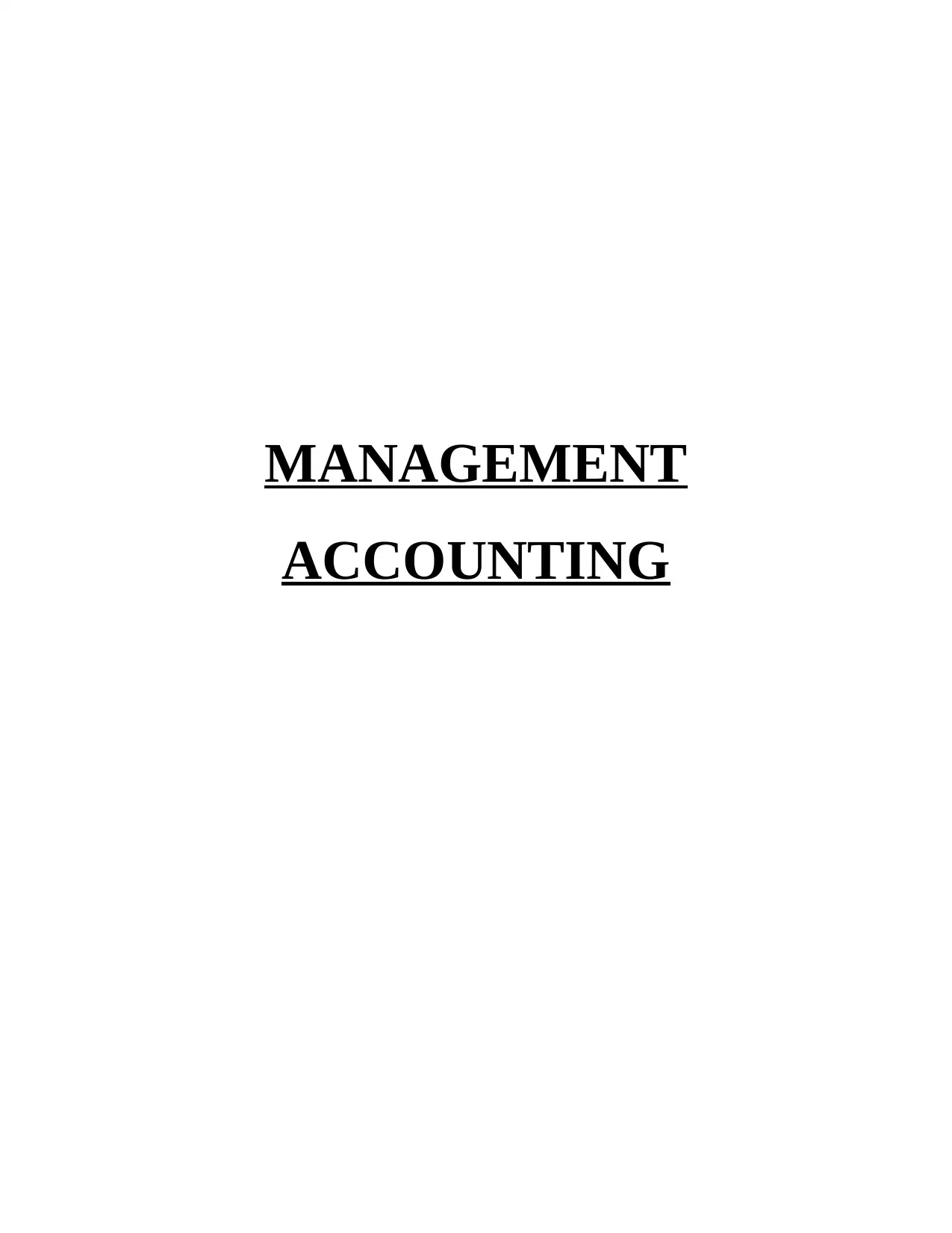
MANAGEMENT
ACCOUNTING
ACCOUNTING
Secure Best Marks with AI Grader
Need help grading? Try our AI Grader for instant feedback on your assignments.
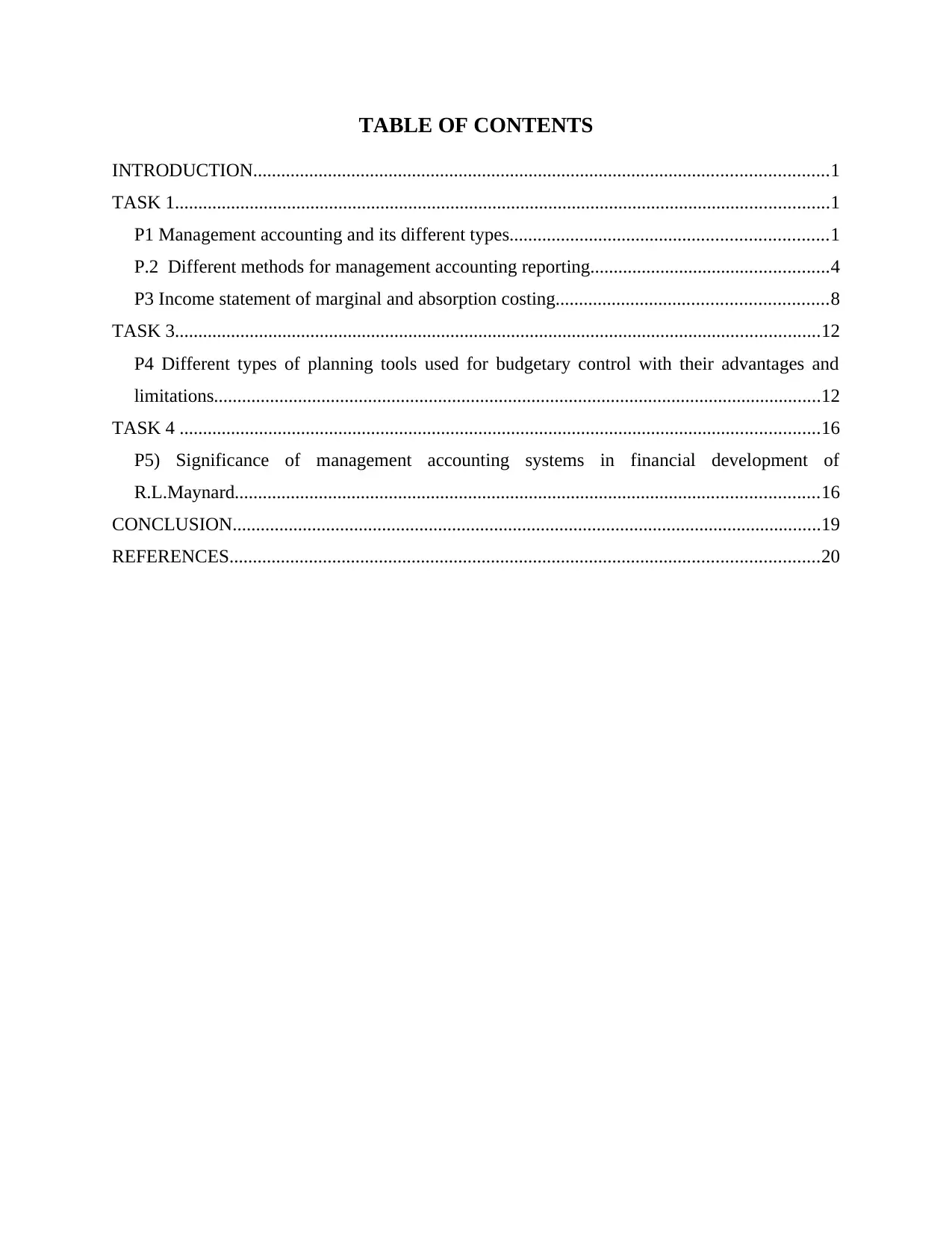
TABLE OF CONTENTS
INTRODUCTION...........................................................................................................................1
TASK 1............................................................................................................................................1
P1 Management accounting and its different types....................................................................1
P.2 Different methods for management accounting reporting...................................................4
P3 Income statement of marginal and absorption costing..........................................................8
TASK 3..........................................................................................................................................12
P4 Different types of planning tools used for budgetary control with their advantages and
limitations..................................................................................................................................12
TASK 4 .........................................................................................................................................16
P5) Significance of management accounting systems in financial development of
R.L.Maynard.............................................................................................................................16
CONCLUSION..............................................................................................................................19
REFERENCES..............................................................................................................................20
INTRODUCTION...........................................................................................................................1
TASK 1............................................................................................................................................1
P1 Management accounting and its different types....................................................................1
P.2 Different methods for management accounting reporting...................................................4
P3 Income statement of marginal and absorption costing..........................................................8
TASK 3..........................................................................................................................................12
P4 Different types of planning tools used for budgetary control with their advantages and
limitations..................................................................................................................................12
TASK 4 .........................................................................................................................................16
P5) Significance of management accounting systems in financial development of
R.L.Maynard.............................................................................................................................16
CONCLUSION..............................................................................................................................19
REFERENCES..............................................................................................................................20
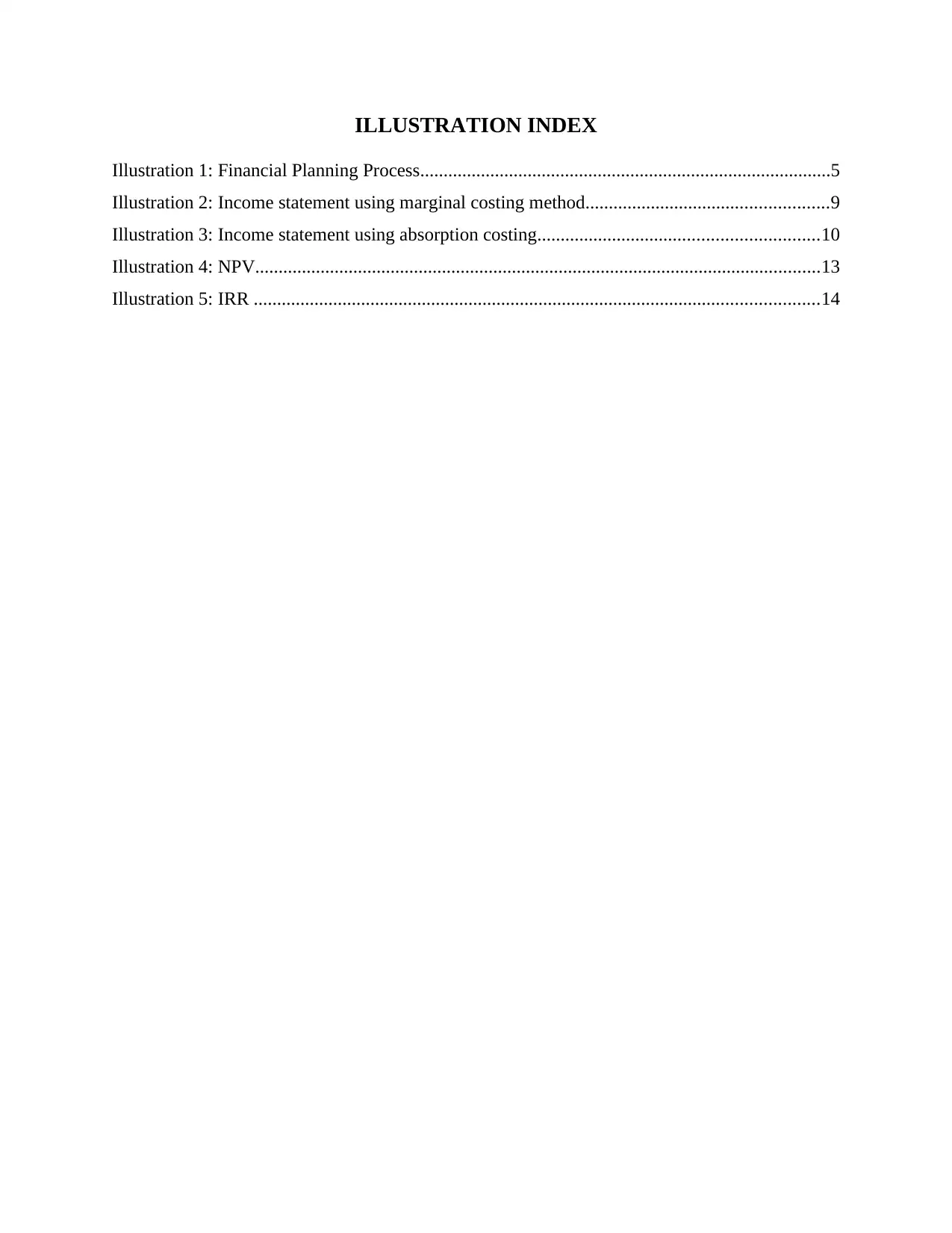
ILLUSTRATION INDEX
Illustration 1: Financial Planning Process........................................................................................5
Illustration 2: Income statement using marginal costing method....................................................9
Illustration 3: Income statement using absorption costing............................................................10
Illustration 4: NPV.........................................................................................................................13
Illustration 5: IRR .........................................................................................................................14
Illustration 1: Financial Planning Process........................................................................................5
Illustration 2: Income statement using marginal costing method....................................................9
Illustration 3: Income statement using absorption costing............................................................10
Illustration 4: NPV.........................................................................................................................13
Illustration 5: IRR .........................................................................................................................14
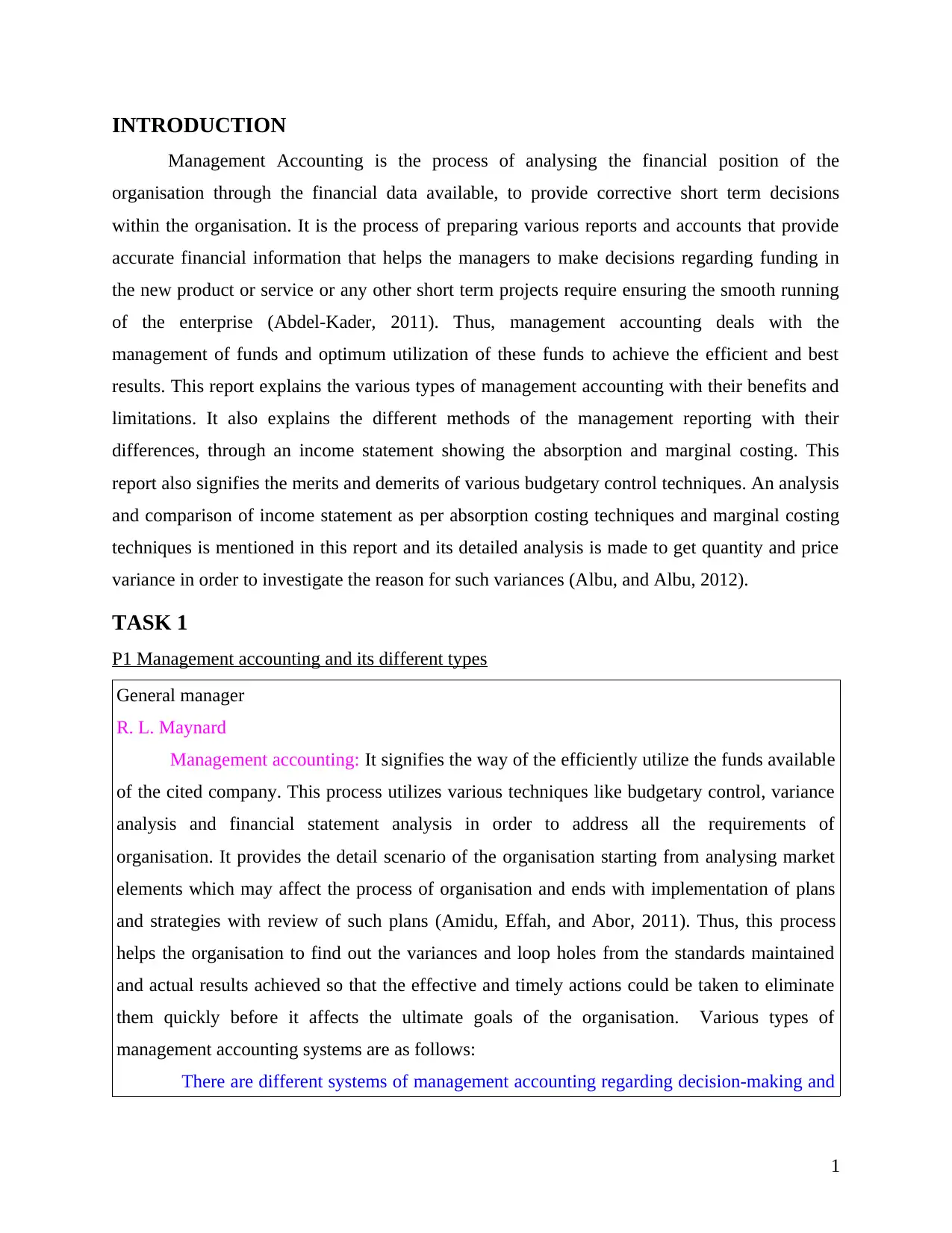
INTRODUCTION
Management Accounting is the process of analysing the financial position of the
organisation through the financial data available, to provide corrective short term decisions
within the organisation. It is the process of preparing various reports and accounts that provide
accurate financial information that helps the managers to make decisions regarding funding in
the new product or service or any other short term projects require ensuring the smooth running
of the enterprise (Abdel-Kader, 2011). Thus, management accounting deals with the
management of funds and optimum utilization of these funds to achieve the efficient and best
results. This report explains the various types of management accounting with their benefits and
limitations. It also explains the different methods of the management reporting with their
differences, through an income statement showing the absorption and marginal costing. This
report also signifies the merits and demerits of various budgetary control techniques. An analysis
and comparison of income statement as per absorption costing techniques and marginal costing
techniques is mentioned in this report and its detailed analysis is made to get quantity and price
variance in order to investigate the reason for such variances (Albu, and Albu, 2012).
TASK 1
P1 Management accounting and its different types
General manager
R. L. Maynard
Management accounting: It signifies the way of the efficiently utilize the funds available
of the cited company. This process utilizes various techniques like budgetary control, variance
analysis and financial statement analysis in order to address all the requirements of
organisation. It provides the detail scenario of the organisation starting from analysing market
elements which may affect the process of organisation and ends with implementation of plans
and strategies with review of such plans (Amidu, Effah, and Abor, 2011). Thus, this process
helps the organisation to find out the variances and loop holes from the standards maintained
and actual results achieved so that the effective and timely actions could be taken to eliminate
them quickly before it affects the ultimate goals of the organisation. Various types of
management accounting systems are as follows:
There are different systems of management accounting regarding decision-making and
1
Management Accounting is the process of analysing the financial position of the
organisation through the financial data available, to provide corrective short term decisions
within the organisation. It is the process of preparing various reports and accounts that provide
accurate financial information that helps the managers to make decisions regarding funding in
the new product or service or any other short term projects require ensuring the smooth running
of the enterprise (Abdel-Kader, 2011). Thus, management accounting deals with the
management of funds and optimum utilization of these funds to achieve the efficient and best
results. This report explains the various types of management accounting with their benefits and
limitations. It also explains the different methods of the management reporting with their
differences, through an income statement showing the absorption and marginal costing. This
report also signifies the merits and demerits of various budgetary control techniques. An analysis
and comparison of income statement as per absorption costing techniques and marginal costing
techniques is mentioned in this report and its detailed analysis is made to get quantity and price
variance in order to investigate the reason for such variances (Albu, and Albu, 2012).
TASK 1
P1 Management accounting and its different types
General manager
R. L. Maynard
Management accounting: It signifies the way of the efficiently utilize the funds available
of the cited company. This process utilizes various techniques like budgetary control, variance
analysis and financial statement analysis in order to address all the requirements of
organisation. It provides the detail scenario of the organisation starting from analysing market
elements which may affect the process of organisation and ends with implementation of plans
and strategies with review of such plans (Amidu, Effah, and Abor, 2011). Thus, this process
helps the organisation to find out the variances and loop holes from the standards maintained
and actual results achieved so that the effective and timely actions could be taken to eliminate
them quickly before it affects the ultimate goals of the organisation. Various types of
management accounting systems are as follows:
There are different systems of management accounting regarding decision-making and
1
Secure Best Marks with AI Grader
Need help grading? Try our AI Grader for instant feedback on your assignments.
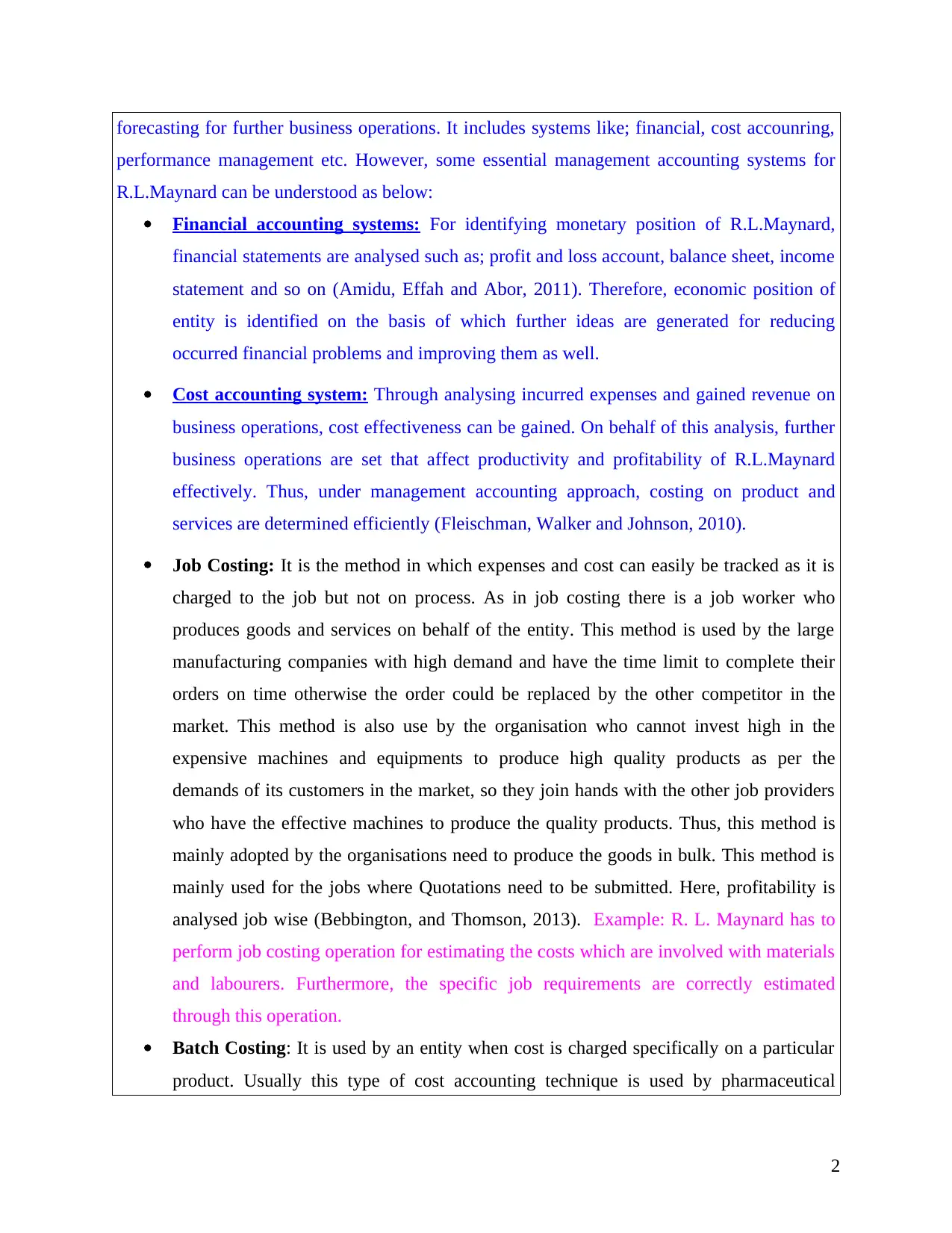
forecasting for further business operations. It includes systems like; financial, cost accounring,
performance management etc. However, some essential management accounting systems for
R.L.Maynard can be understood as below:
Financial accounting systems: For identifying monetary position of R.L.Maynard,
financial statements are analysed such as; profit and loss account, balance sheet, income
statement and so on (Amidu, Effah and Abor, 2011). Therefore, economic position of
entity is identified on the basis of which further ideas are generated for reducing
occurred financial problems and improving them as well.
Cost accounting system: Through analysing incurred expenses and gained revenue on
business operations, cost effectiveness can be gained. On behalf of this analysis, further
business operations are set that affect productivity and profitability of R.L.Maynard
effectively. Thus, under management accounting approach, costing on product and
services are determined efficiently (Fleischman, Walker and Johnson, 2010).
Job Costing: It is the method in which expenses and cost can easily be tracked as it is
charged to the job but not on process. As in job costing there is a job worker who
produces goods and services on behalf of the entity. This method is used by the large
manufacturing companies with high demand and have the time limit to complete their
orders on time otherwise the order could be replaced by the other competitor in the
market. This method is also use by the organisation who cannot invest high in the
expensive machines and equipments to produce high quality products as per the
demands of its customers in the market, so they join hands with the other job providers
who have the effective machines to produce the quality products. Thus, this method is
mainly adopted by the organisations need to produce the goods in bulk. This method is
mainly used for the jobs where Quotations need to be submitted. Here, profitability is
analysed job wise (Bebbington, and Thomson, 2013). Example: R. L. Maynard has to
perform job costing operation for estimating the costs which are involved with materials
and labourers. Furthermore, the specific job requirements are correctly estimated
through this operation.
Batch Costing: It is used by an entity when cost is charged specifically on a particular
product. Usually this type of cost accounting technique is used by pharmaceutical
2
performance management etc. However, some essential management accounting systems for
R.L.Maynard can be understood as below:
Financial accounting systems: For identifying monetary position of R.L.Maynard,
financial statements are analysed such as; profit and loss account, balance sheet, income
statement and so on (Amidu, Effah and Abor, 2011). Therefore, economic position of
entity is identified on the basis of which further ideas are generated for reducing
occurred financial problems and improving them as well.
Cost accounting system: Through analysing incurred expenses and gained revenue on
business operations, cost effectiveness can be gained. On behalf of this analysis, further
business operations are set that affect productivity and profitability of R.L.Maynard
effectively. Thus, under management accounting approach, costing on product and
services are determined efficiently (Fleischman, Walker and Johnson, 2010).
Job Costing: It is the method in which expenses and cost can easily be tracked as it is
charged to the job but not on process. As in job costing there is a job worker who
produces goods and services on behalf of the entity. This method is used by the large
manufacturing companies with high demand and have the time limit to complete their
orders on time otherwise the order could be replaced by the other competitor in the
market. This method is also use by the organisation who cannot invest high in the
expensive machines and equipments to produce high quality products as per the
demands of its customers in the market, so they join hands with the other job providers
who have the effective machines to produce the quality products. Thus, this method is
mainly adopted by the organisations need to produce the goods in bulk. This method is
mainly used for the jobs where Quotations need to be submitted. Here, profitability is
analysed job wise (Bebbington, and Thomson, 2013). Example: R. L. Maynard has to
perform job costing operation for estimating the costs which are involved with materials
and labourers. Furthermore, the specific job requirements are correctly estimated
through this operation.
Batch Costing: It is used by an entity when cost is charged specifically on a particular
product. Usually this type of cost accounting technique is used by pharmaceutical
2
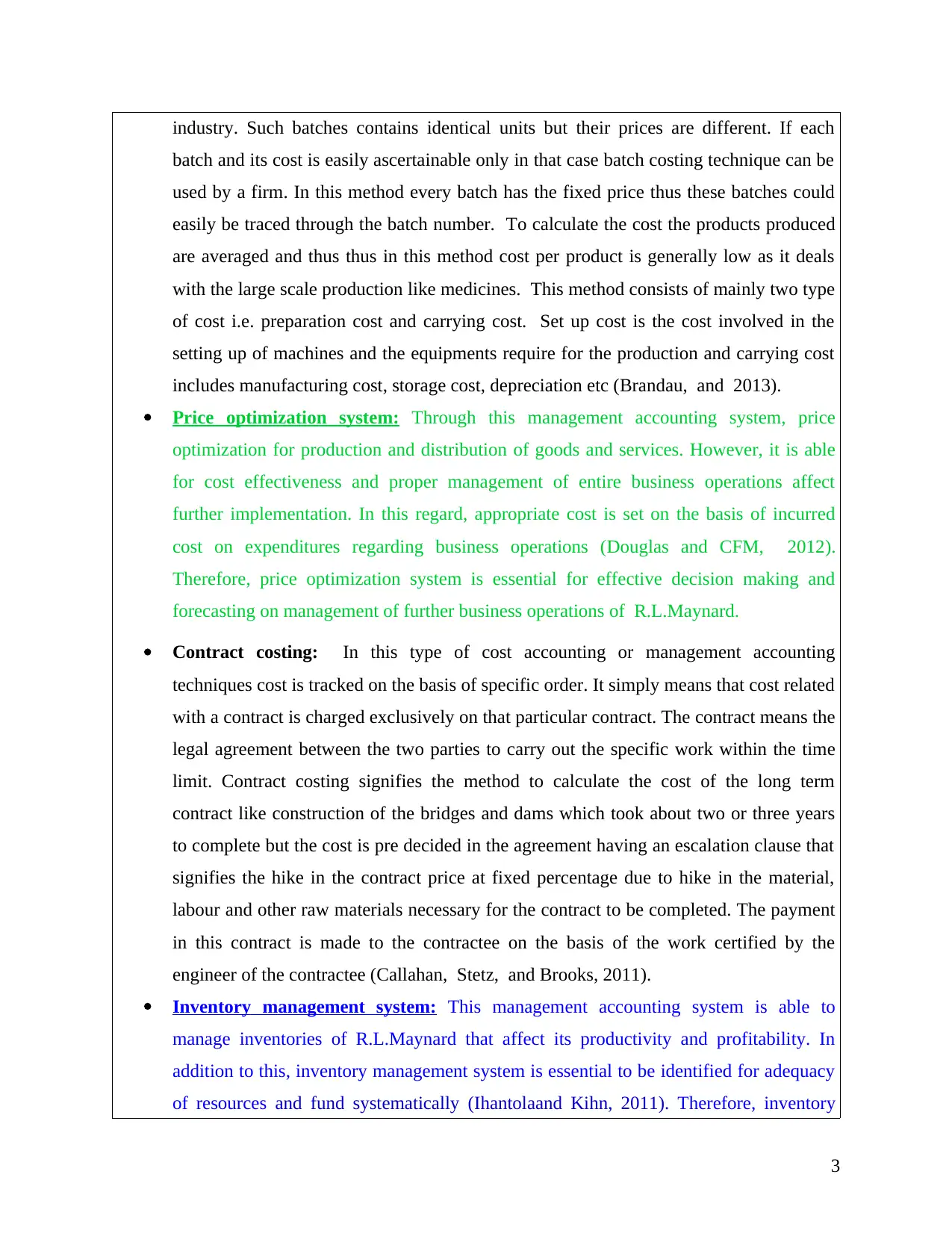
industry. Such batches contains identical units but their prices are different. If each
batch and its cost is easily ascertainable only in that case batch costing technique can be
used by a firm. In this method every batch has the fixed price thus these batches could
easily be traced through the batch number. To calculate the cost the products produced
are averaged and thus thus in this method cost per product is generally low as it deals
with the large scale production like medicines. This method consists of mainly two type
of cost i.e. preparation cost and carrying cost. Set up cost is the cost involved in the
setting up of machines and the equipments require for the production and carrying cost
includes manufacturing cost, storage cost, depreciation etc (Brandau, and 2013).
Price optimization system: Through this management accounting system, price
optimization for production and distribution of goods and services. However, it is able
for cost effectiveness and proper management of entire business operations affect
further implementation. In this regard, appropriate cost is set on the basis of incurred
cost on expenditures regarding business operations (Douglas and CFM, 2012).
Therefore, price optimization system is essential for effective decision making and
forecasting on management of further business operations of R.L.Maynard.
Contract costing: In this type of cost accounting or management accounting
techniques cost is tracked on the basis of specific order. It simply means that cost related
with a contract is charged exclusively on that particular contract. The contract means the
legal agreement between the two parties to carry out the specific work within the time
limit. Contract costing signifies the method to calculate the cost of the long term
contract like construction of the bridges and dams which took about two or three years
to complete but the cost is pre decided in the agreement having an escalation clause that
signifies the hike in the contract price at fixed percentage due to hike in the material,
labour and other raw materials necessary for the contract to be completed. The payment
in this contract is made to the contractee on the basis of the work certified by the
engineer of the contractee (Callahan, Stetz, and Brooks, 2011).
Inventory management system: This management accounting system is able to
manage inventories of R.L.Maynard that affect its productivity and profitability. In
addition to this, inventory management system is essential to be identified for adequacy
of resources and fund systematically (Ihantolaand Kihn, 2011). Therefore, inventory
3
batch and its cost is easily ascertainable only in that case batch costing technique can be
used by a firm. In this method every batch has the fixed price thus these batches could
easily be traced through the batch number. To calculate the cost the products produced
are averaged and thus thus in this method cost per product is generally low as it deals
with the large scale production like medicines. This method consists of mainly two type
of cost i.e. preparation cost and carrying cost. Set up cost is the cost involved in the
setting up of machines and the equipments require for the production and carrying cost
includes manufacturing cost, storage cost, depreciation etc (Brandau, and 2013).
Price optimization system: Through this management accounting system, price
optimization for production and distribution of goods and services. However, it is able
for cost effectiveness and proper management of entire business operations affect
further implementation. In this regard, appropriate cost is set on the basis of incurred
cost on expenditures regarding business operations (Douglas and CFM, 2012).
Therefore, price optimization system is essential for effective decision making and
forecasting on management of further business operations of R.L.Maynard.
Contract costing: In this type of cost accounting or management accounting
techniques cost is tracked on the basis of specific order. It simply means that cost related
with a contract is charged exclusively on that particular contract. The contract means the
legal agreement between the two parties to carry out the specific work within the time
limit. Contract costing signifies the method to calculate the cost of the long term
contract like construction of the bridges and dams which took about two or three years
to complete but the cost is pre decided in the agreement having an escalation clause that
signifies the hike in the contract price at fixed percentage due to hike in the material,
labour and other raw materials necessary for the contract to be completed. The payment
in this contract is made to the contractee on the basis of the work certified by the
engineer of the contractee (Callahan, Stetz, and Brooks, 2011).
Inventory management system: This management accounting system is able to
manage inventories of R.L.Maynard that affect its productivity and profitability. In
addition to this, inventory management system is essential to be identified for adequacy
of resources and fund systematically (Ihantolaand Kihn, 2011). Therefore, inventory
3
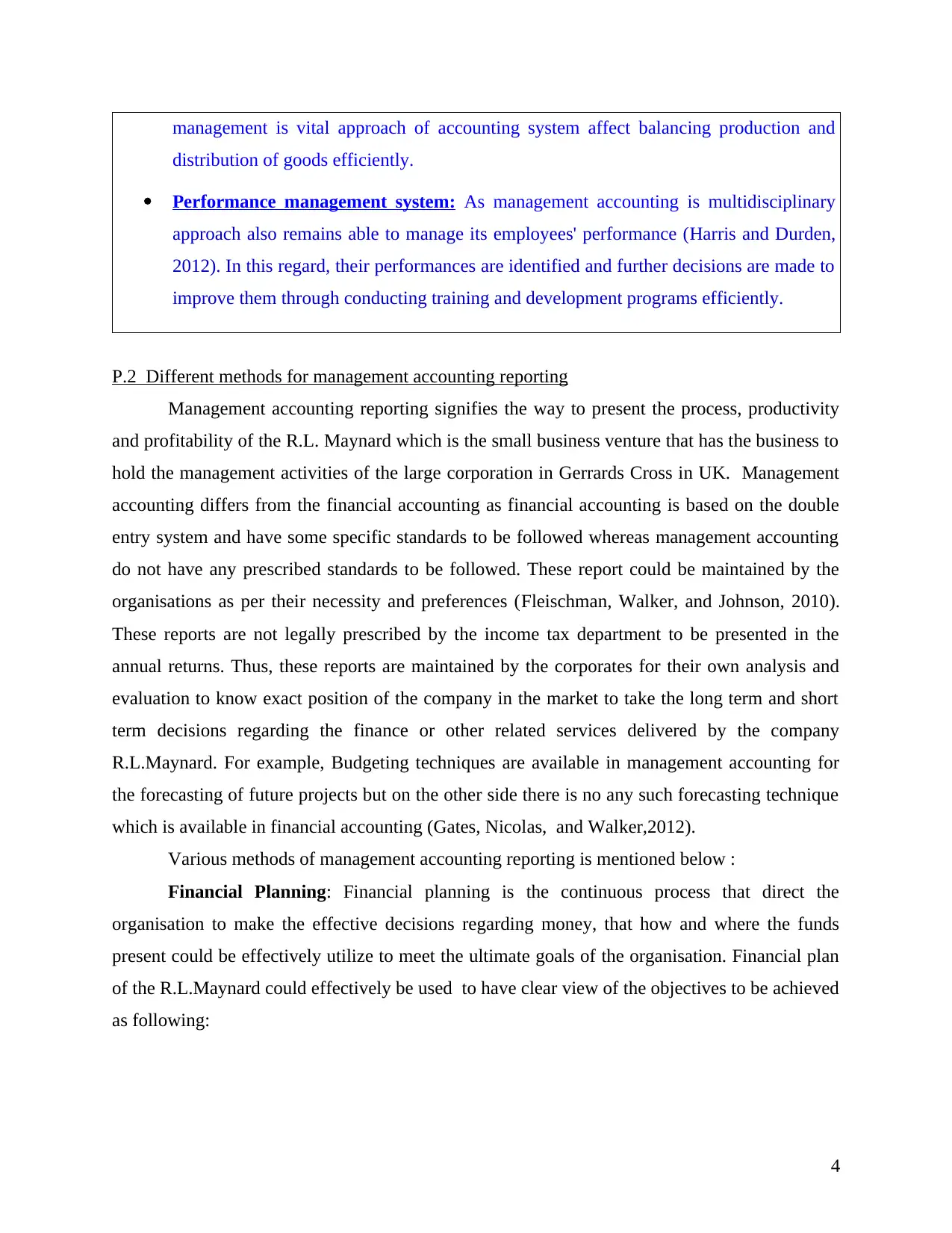
management is vital approach of accounting system affect balancing production and
distribution of goods efficiently.
Performance management system: As management accounting is multidisciplinary
approach also remains able to manage its employees' performance (Harris and Durden,
2012). In this regard, their performances are identified and further decisions are made to
improve them through conducting training and development programs efficiently.
P.2 Different methods for management accounting reporting
Management accounting reporting signifies the way to present the process, productivity
and profitability of the R.L. Maynard which is the small business venture that has the business to
hold the management activities of the large corporation in Gerrards Cross in UK. Management
accounting differs from the financial accounting as financial accounting is based on the double
entry system and have some specific standards to be followed whereas management accounting
do not have any prescribed standards to be followed. These report could be maintained by the
organisations as per their necessity and preferences (Fleischman, Walker, and Johnson, 2010).
These reports are not legally prescribed by the income tax department to be presented in the
annual returns. Thus, these reports are maintained by the corporates for their own analysis and
evaluation to know exact position of the company in the market to take the long term and short
term decisions regarding the finance or other related services delivered by the company
R.L.Maynard. For example, Budgeting techniques are available in management accounting for
the forecasting of future projects but on the other side there is no any such forecasting technique
which is available in financial accounting (Gates, Nicolas, and Walker,2012).
Various methods of management accounting reporting is mentioned below :
Financial Planning: Financial planning is the continuous process that direct the
organisation to make the effective decisions regarding money, that how and where the funds
present could be effectively utilize to meet the ultimate goals of the organisation. Financial plan
of the R.L.Maynard could effectively be used to have clear view of the objectives to be achieved
as following:
4
distribution of goods efficiently.
Performance management system: As management accounting is multidisciplinary
approach also remains able to manage its employees' performance (Harris and Durden,
2012). In this regard, their performances are identified and further decisions are made to
improve them through conducting training and development programs efficiently.
P.2 Different methods for management accounting reporting
Management accounting reporting signifies the way to present the process, productivity
and profitability of the R.L. Maynard which is the small business venture that has the business to
hold the management activities of the large corporation in Gerrards Cross in UK. Management
accounting differs from the financial accounting as financial accounting is based on the double
entry system and have some specific standards to be followed whereas management accounting
do not have any prescribed standards to be followed. These report could be maintained by the
organisations as per their necessity and preferences (Fleischman, Walker, and Johnson, 2010).
These reports are not legally prescribed by the income tax department to be presented in the
annual returns. Thus, these reports are maintained by the corporates for their own analysis and
evaluation to know exact position of the company in the market to take the long term and short
term decisions regarding the finance or other related services delivered by the company
R.L.Maynard. For example, Budgeting techniques are available in management accounting for
the forecasting of future projects but on the other side there is no any such forecasting technique
which is available in financial accounting (Gates, Nicolas, and Walker,2012).
Various methods of management accounting reporting is mentioned below :
Financial Planning: Financial planning is the continuous process that direct the
organisation to make the effective decisions regarding money, that how and where the funds
present could be effectively utilize to meet the ultimate goals of the organisation. Financial plan
of the R.L.Maynard could effectively be used to have clear view of the objectives to be achieved
as following:
4
Paraphrase This Document
Need a fresh take? Get an instant paraphrase of this document with our AI Paraphraser
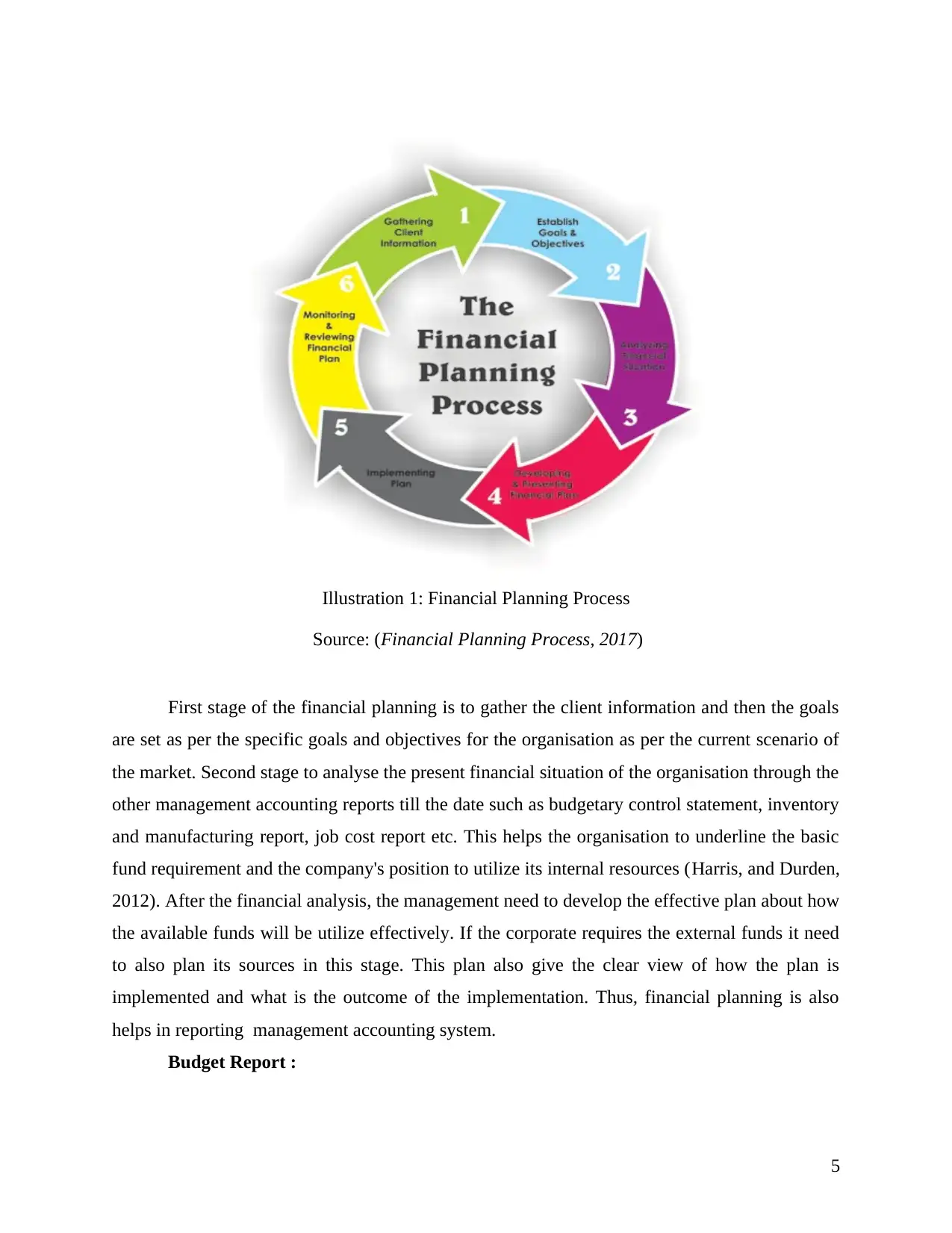
First stage of the financial planning is to gather the client information and then the goals
are set as per the specific goals and objectives for the organisation as per the current scenario of
the market. Second stage to analyse the present financial situation of the organisation through the
other management accounting reports till the date such as budgetary control statement, inventory
and manufacturing report, job cost report etc. This helps the organisation to underline the basic
fund requirement and the company's position to utilize its internal resources (Harris, and Durden,
2012). After the financial analysis, the management need to develop the effective plan about how
the available funds will be utilize effectively. If the corporate requires the external funds it need
to also plan its sources in this stage. This plan also give the clear view of how the plan is
implemented and what is the outcome of the implementation. Thus, financial planning is also
helps in reporting management accounting system.
Budget Report :
5
Illustration 1: Financial Planning Process
Source: (Financial Planning Process, 2017)
are set as per the specific goals and objectives for the organisation as per the current scenario of
the market. Second stage to analyse the present financial situation of the organisation through the
other management accounting reports till the date such as budgetary control statement, inventory
and manufacturing report, job cost report etc. This helps the organisation to underline the basic
fund requirement and the company's position to utilize its internal resources (Harris, and Durden,
2012). After the financial analysis, the management need to develop the effective plan about how
the available funds will be utilize effectively. If the corporate requires the external funds it need
to also plan its sources in this stage. This plan also give the clear view of how the plan is
implemented and what is the outcome of the implementation. Thus, financial planning is also
helps in reporting management accounting system.
Budget Report :
5
Illustration 1: Financial Planning Process
Source: (Financial Planning Process, 2017)
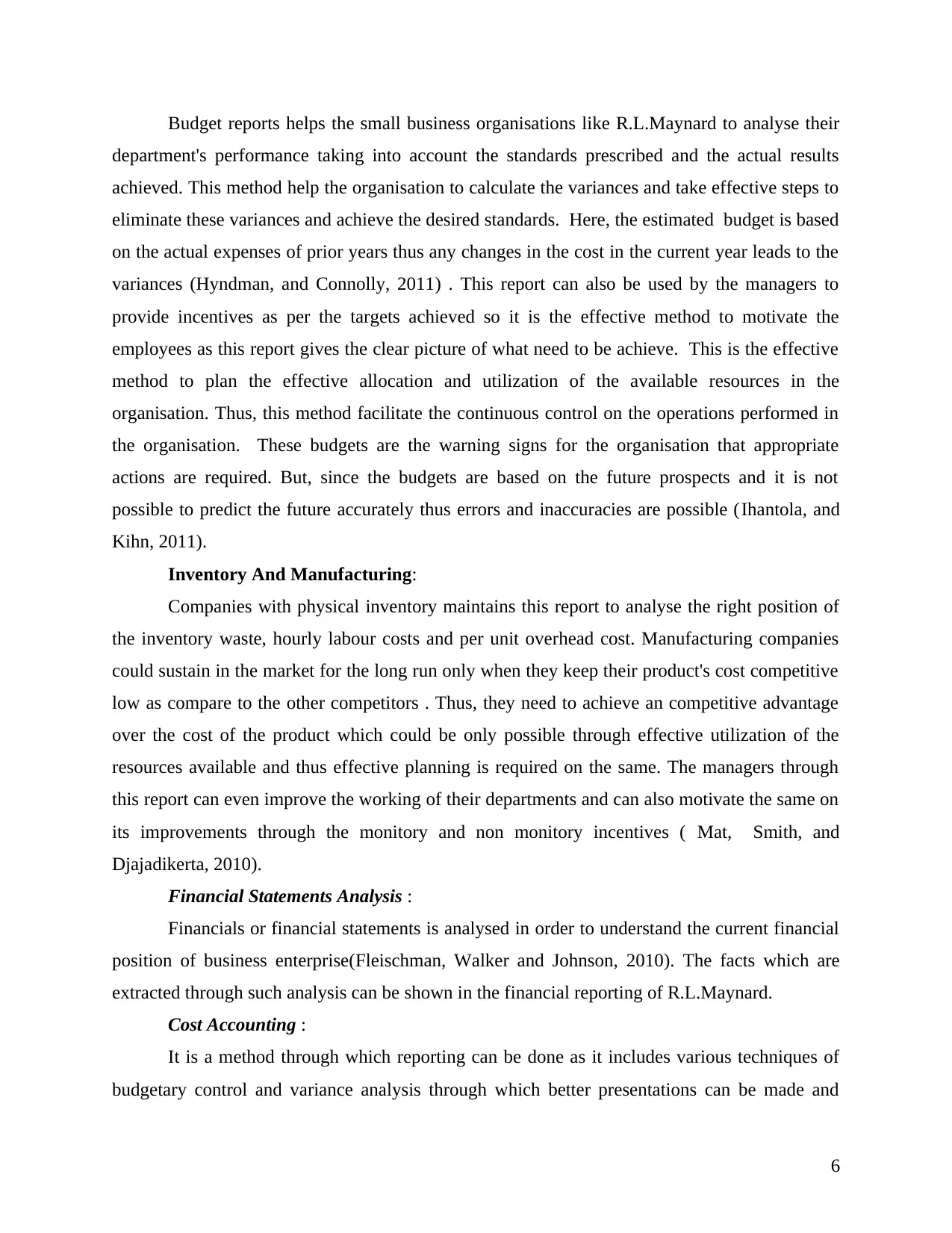
Budget reports helps the small business organisations like R.L.Maynard to analyse their
department's performance taking into account the standards prescribed and the actual results
achieved. This method help the organisation to calculate the variances and take effective steps to
eliminate these variances and achieve the desired standards. Here, the estimated budget is based
on the actual expenses of prior years thus any changes in the cost in the current year leads to the
variances (Hyndman, and Connolly, 2011) . This report can also be used by the managers to
provide incentives as per the targets achieved so it is the effective method to motivate the
employees as this report gives the clear picture of what need to be achieve. This is the effective
method to plan the effective allocation and utilization of the available resources in the
organisation. Thus, this method facilitate the continuous control on the operations performed in
the organisation. These budgets are the warning signs for the organisation that appropriate
actions are required. But, since the budgets are based on the future prospects and it is not
possible to predict the future accurately thus errors and inaccuracies are possible (Ihantola, and
Kihn, 2011).
Inventory And Manufacturing:
Companies with physical inventory maintains this report to analyse the right position of
the inventory waste, hourly labour costs and per unit overhead cost. Manufacturing companies
could sustain in the market for the long run only when they keep their product's cost competitive
low as compare to the other competitors . Thus, they need to achieve an competitive advantage
over the cost of the product which could be only possible through effective utilization of the
resources available and thus effective planning is required on the same. The managers through
this report can even improve the working of their departments and can also motivate the same on
its improvements through the monitory and non monitory incentives ( Mat, Smith, and
Djajadikerta, 2010).
Financial Statements Analysis :
Financials or financial statements is analysed in order to understand the current financial
position of business enterprise(Fleischman, Walker and Johnson, 2010). The facts which are
extracted through such analysis can be shown in the financial reporting of R.L.Maynard.
Cost Accounting :
It is a method through which reporting can be done as it includes various techniques of
budgetary control and variance analysis through which better presentations can be made and
6
department's performance taking into account the standards prescribed and the actual results
achieved. This method help the organisation to calculate the variances and take effective steps to
eliminate these variances and achieve the desired standards. Here, the estimated budget is based
on the actual expenses of prior years thus any changes in the cost in the current year leads to the
variances (Hyndman, and Connolly, 2011) . This report can also be used by the managers to
provide incentives as per the targets achieved so it is the effective method to motivate the
employees as this report gives the clear picture of what need to be achieve. This is the effective
method to plan the effective allocation and utilization of the available resources in the
organisation. Thus, this method facilitate the continuous control on the operations performed in
the organisation. These budgets are the warning signs for the organisation that appropriate
actions are required. But, since the budgets are based on the future prospects and it is not
possible to predict the future accurately thus errors and inaccuracies are possible (Ihantola, and
Kihn, 2011).
Inventory And Manufacturing:
Companies with physical inventory maintains this report to analyse the right position of
the inventory waste, hourly labour costs and per unit overhead cost. Manufacturing companies
could sustain in the market for the long run only when they keep their product's cost competitive
low as compare to the other competitors . Thus, they need to achieve an competitive advantage
over the cost of the product which could be only possible through effective utilization of the
resources available and thus effective planning is required on the same. The managers through
this report can even improve the working of their departments and can also motivate the same on
its improvements through the monitory and non monitory incentives ( Mat, Smith, and
Djajadikerta, 2010).
Financial Statements Analysis :
Financials or financial statements is analysed in order to understand the current financial
position of business enterprise(Fleischman, Walker and Johnson, 2010). The facts which are
extracted through such analysis can be shown in the financial reporting of R.L.Maynard.
Cost Accounting :
It is a method through which reporting can be done as it includes various techniques of
budgetary control and variance analysis through which better presentations can be made and
6
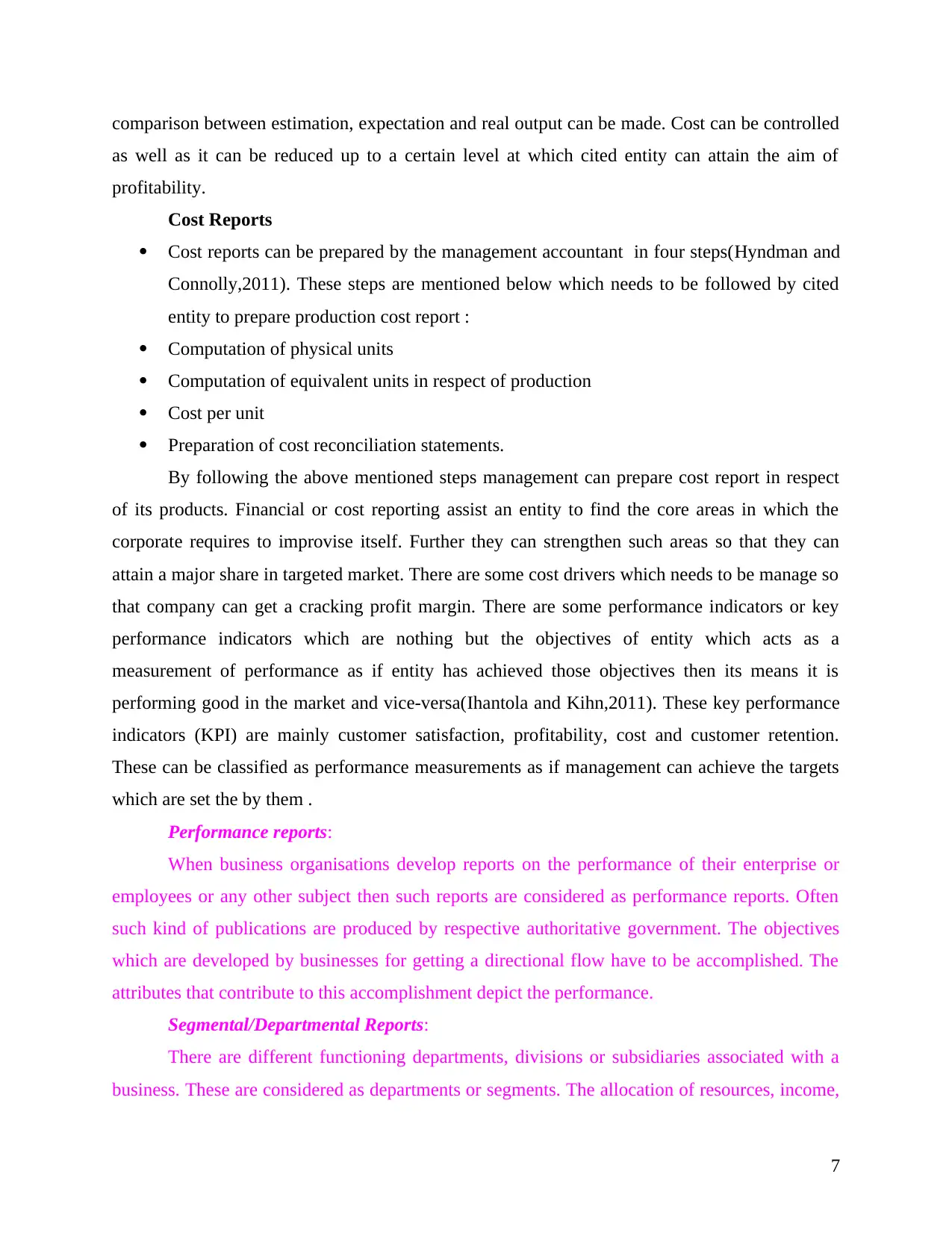
comparison between estimation, expectation and real output can be made. Cost can be controlled
as well as it can be reduced up to a certain level at which cited entity can attain the aim of
profitability.
Cost Reports
Cost reports can be prepared by the management accountant in four steps(Hyndman and
Connolly,2011). These steps are mentioned below which needs to be followed by cited
entity to prepare production cost report :
Computation of physical units
Computation of equivalent units in respect of production
Cost per unit
Preparation of cost reconciliation statements.
By following the above mentioned steps management can prepare cost report in respect
of its products. Financial or cost reporting assist an entity to find the core areas in which the
corporate requires to improvise itself. Further they can strengthen such areas so that they can
attain a major share in targeted market. There are some cost drivers which needs to be manage so
that company can get a cracking profit margin. There are some performance indicators or key
performance indicators which are nothing but the objectives of entity which acts as a
measurement of performance as if entity has achieved those objectives then its means it is
performing good in the market and vice-versa(Ihantola and Kihn,2011). These key performance
indicators (KPI) are mainly customer satisfaction, profitability, cost and customer retention.
These can be classified as performance measurements as if management can achieve the targets
which are set the by them .
Performance reports:
When business organisations develop reports on the performance of their enterprise or
employees or any other subject then such reports are considered as performance reports. Often
such kind of publications are produced by respective authoritative government. The objectives
which are developed by businesses for getting a directional flow have to be accomplished. The
attributes that contribute to this accomplishment depict the performance.
Segmental/Departmental Reports:
There are different functioning departments, divisions or subsidiaries associated with a
business. These are considered as departments or segments. The allocation of resources, income,
7
as well as it can be reduced up to a certain level at which cited entity can attain the aim of
profitability.
Cost Reports
Cost reports can be prepared by the management accountant in four steps(Hyndman and
Connolly,2011). These steps are mentioned below which needs to be followed by cited
entity to prepare production cost report :
Computation of physical units
Computation of equivalent units in respect of production
Cost per unit
Preparation of cost reconciliation statements.
By following the above mentioned steps management can prepare cost report in respect
of its products. Financial or cost reporting assist an entity to find the core areas in which the
corporate requires to improvise itself. Further they can strengthen such areas so that they can
attain a major share in targeted market. There are some cost drivers which needs to be manage so
that company can get a cracking profit margin. There are some performance indicators or key
performance indicators which are nothing but the objectives of entity which acts as a
measurement of performance as if entity has achieved those objectives then its means it is
performing good in the market and vice-versa(Ihantola and Kihn,2011). These key performance
indicators (KPI) are mainly customer satisfaction, profitability, cost and customer retention.
These can be classified as performance measurements as if management can achieve the targets
which are set the by them .
Performance reports:
When business organisations develop reports on the performance of their enterprise or
employees or any other subject then such reports are considered as performance reports. Often
such kind of publications are produced by respective authoritative government. The objectives
which are developed by businesses for getting a directional flow have to be accomplished. The
attributes that contribute to this accomplishment depict the performance.
Segmental/Departmental Reports:
There are different functioning departments, divisions or subsidiaries associated with a
business. These are considered as departments or segments. The allocation of resources, income,
7
Secure Best Marks with AI Grader
Need help grading? Try our AI Grader for instant feedback on your assignments.
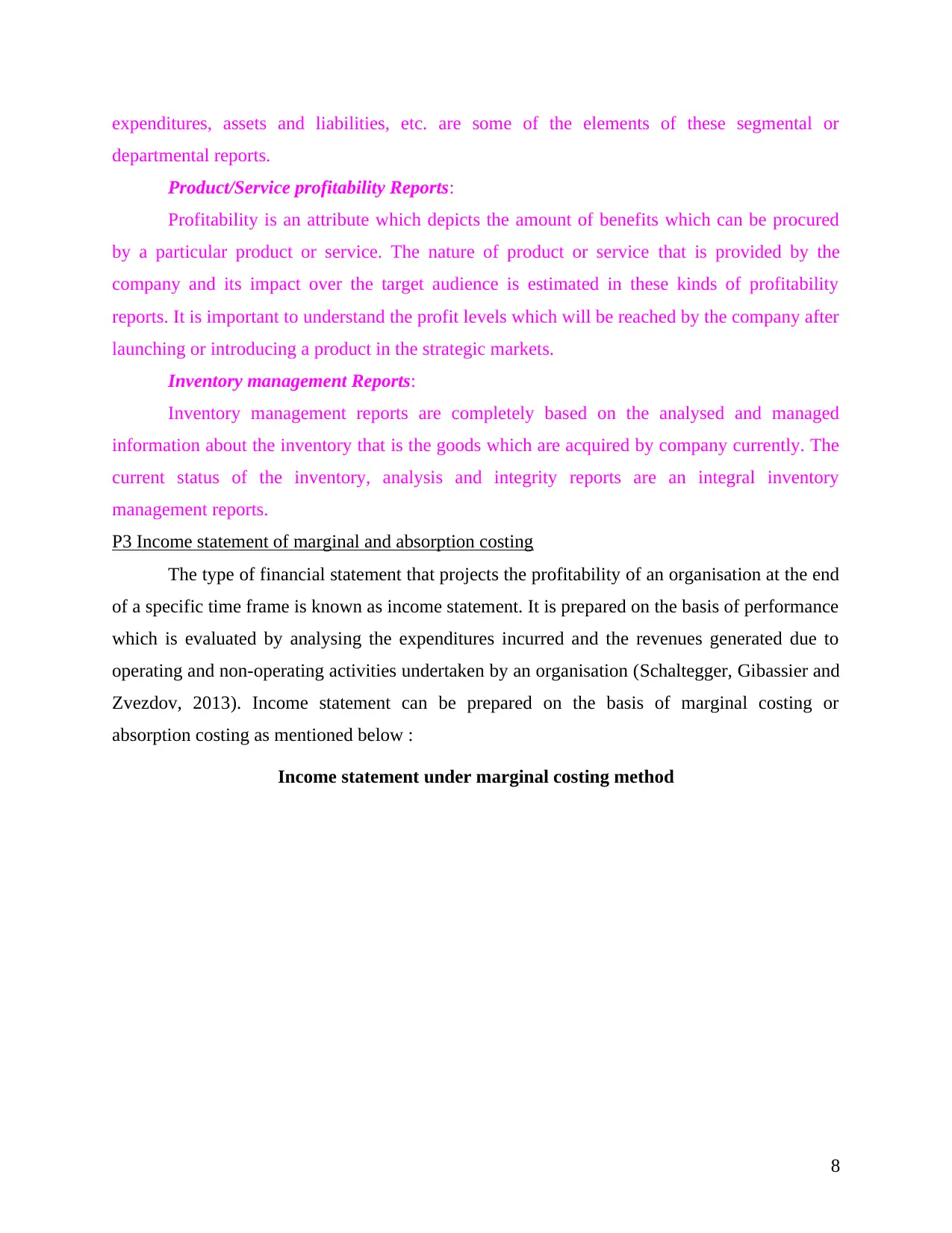
expenditures, assets and liabilities, etc. are some of the elements of these segmental or
departmental reports.
Product/Service profitability Reports:
Profitability is an attribute which depicts the amount of benefits which can be procured
by a particular product or service. The nature of product or service that is provided by the
company and its impact over the target audience is estimated in these kinds of profitability
reports. It is important to understand the profit levels which will be reached by the company after
launching or introducing a product in the strategic markets.
Inventory management Reports:
Inventory management reports are completely based on the analysed and managed
information about the inventory that is the goods which are acquired by company currently. The
current status of the inventory, analysis and integrity reports are an integral inventory
management reports.
P3 Income statement of marginal and absorption costing
The type of financial statement that projects the profitability of an organisation at the end
of a specific time frame is known as income statement. It is prepared on the basis of performance
which is evaluated by analysing the expenditures incurred and the revenues generated due to
operating and non-operating activities undertaken by an organisation (Schaltegger, Gibassier and
Zvezdov, 2013). Income statement can be prepared on the basis of marginal costing or
absorption costing as mentioned below :
Income statement under marginal costing method
8
departmental reports.
Product/Service profitability Reports:
Profitability is an attribute which depicts the amount of benefits which can be procured
by a particular product or service. The nature of product or service that is provided by the
company and its impact over the target audience is estimated in these kinds of profitability
reports. It is important to understand the profit levels which will be reached by the company after
launching or introducing a product in the strategic markets.
Inventory management Reports:
Inventory management reports are completely based on the analysed and managed
information about the inventory that is the goods which are acquired by company currently. The
current status of the inventory, analysis and integrity reports are an integral inventory
management reports.
P3 Income statement of marginal and absorption costing
The type of financial statement that projects the profitability of an organisation at the end
of a specific time frame is known as income statement. It is prepared on the basis of performance
which is evaluated by analysing the expenditures incurred and the revenues generated due to
operating and non-operating activities undertaken by an organisation (Schaltegger, Gibassier and
Zvezdov, 2013). Income statement can be prepared on the basis of marginal costing or
absorption costing as mentioned below :
Income statement under marginal costing method
8
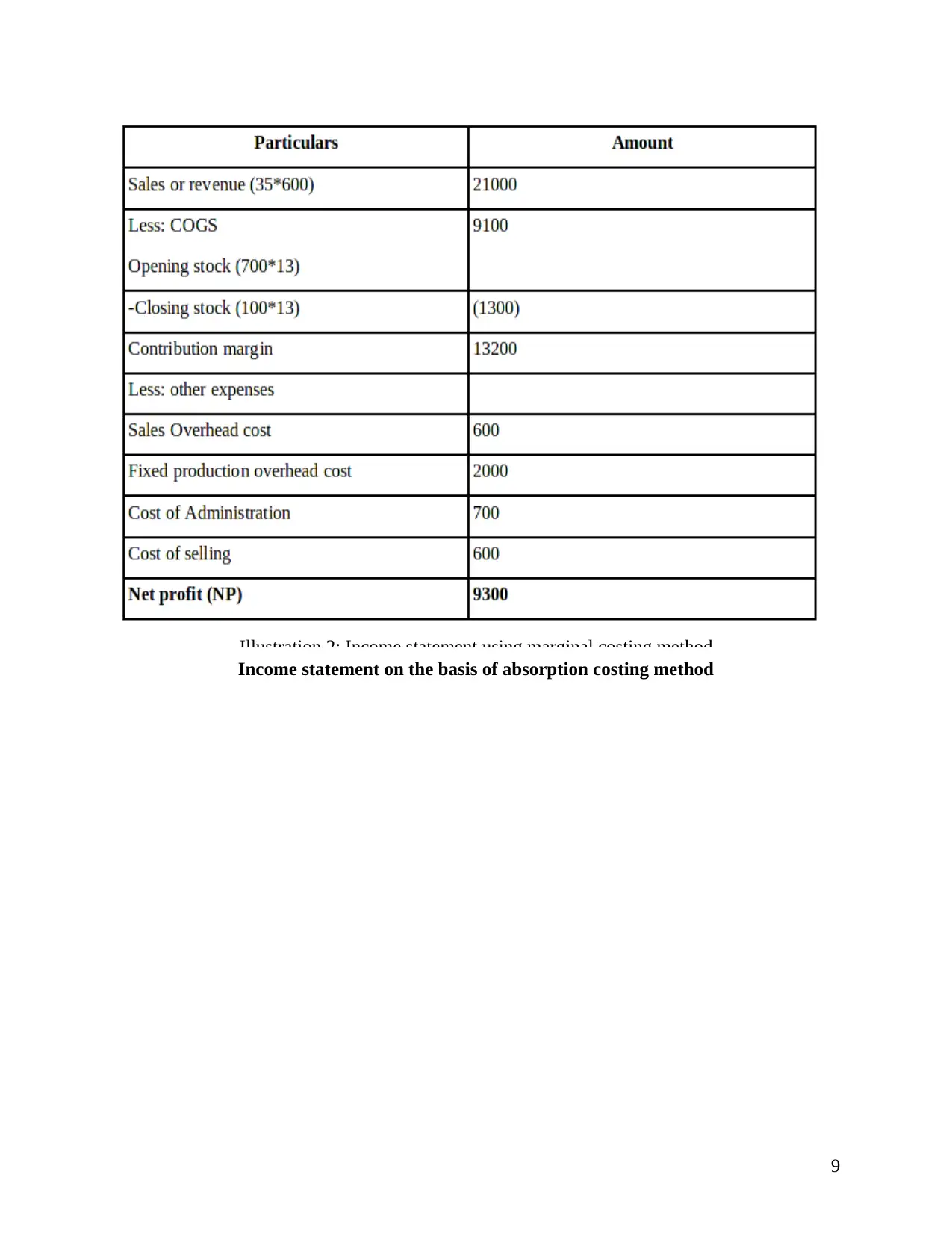
Income statement on the basis of absorption costing method
9
Illustration 2: Income statement using marginal costing method
9
Illustration 2: Income statement using marginal costing method
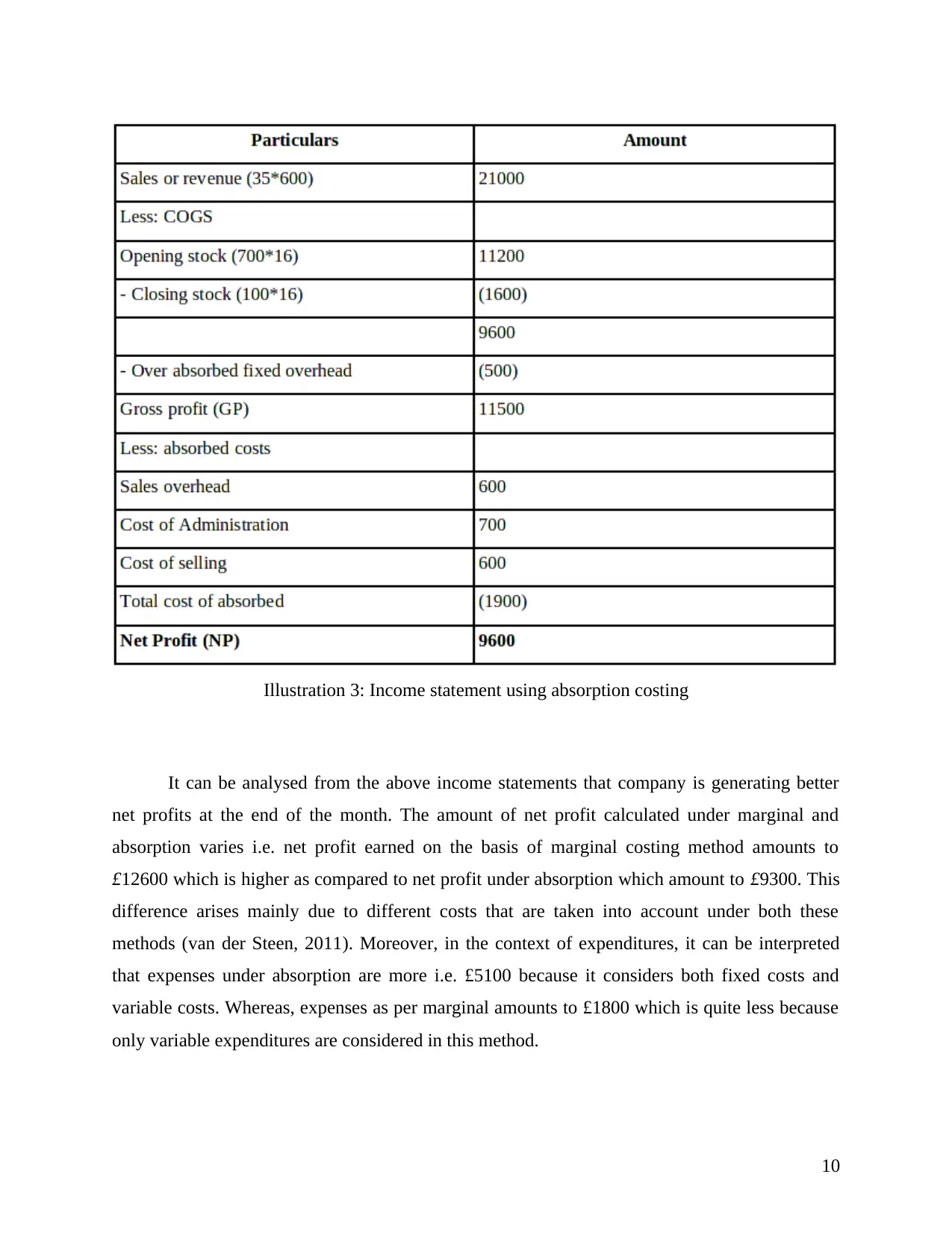
It can be analysed from the above income statements that company is generating better
net profits at the end of the month. The amount of net profit calculated under marginal and
absorption varies i.e. net profit earned on the basis of marginal costing method amounts to
£12600 which is higher as compared to net profit under absorption which amount to £9300. This
difference arises mainly due to different costs that are taken into account under both these
methods (van der Steen, 2011). Moreover, in the context of expenditures, it can be interpreted
that expenses under absorption are more i.e. £5100 because it considers both fixed costs and
variable costs. Whereas, expenses as per marginal amounts to £1800 which is quite less because
only variable expenditures are considered in this method.
10
Illustration 3: Income statement using absorption costing
net profits at the end of the month. The amount of net profit calculated under marginal and
absorption varies i.e. net profit earned on the basis of marginal costing method amounts to
£12600 which is higher as compared to net profit under absorption which amount to £9300. This
difference arises mainly due to different costs that are taken into account under both these
methods (van der Steen, 2011). Moreover, in the context of expenditures, it can be interpreted
that expenses under absorption are more i.e. £5100 because it considers both fixed costs and
variable costs. Whereas, expenses as per marginal amounts to £1800 which is quite less because
only variable expenditures are considered in this method.
10
Illustration 3: Income statement using absorption costing
Paraphrase This Document
Need a fresh take? Get an instant paraphrase of this document with our AI Paraphraser
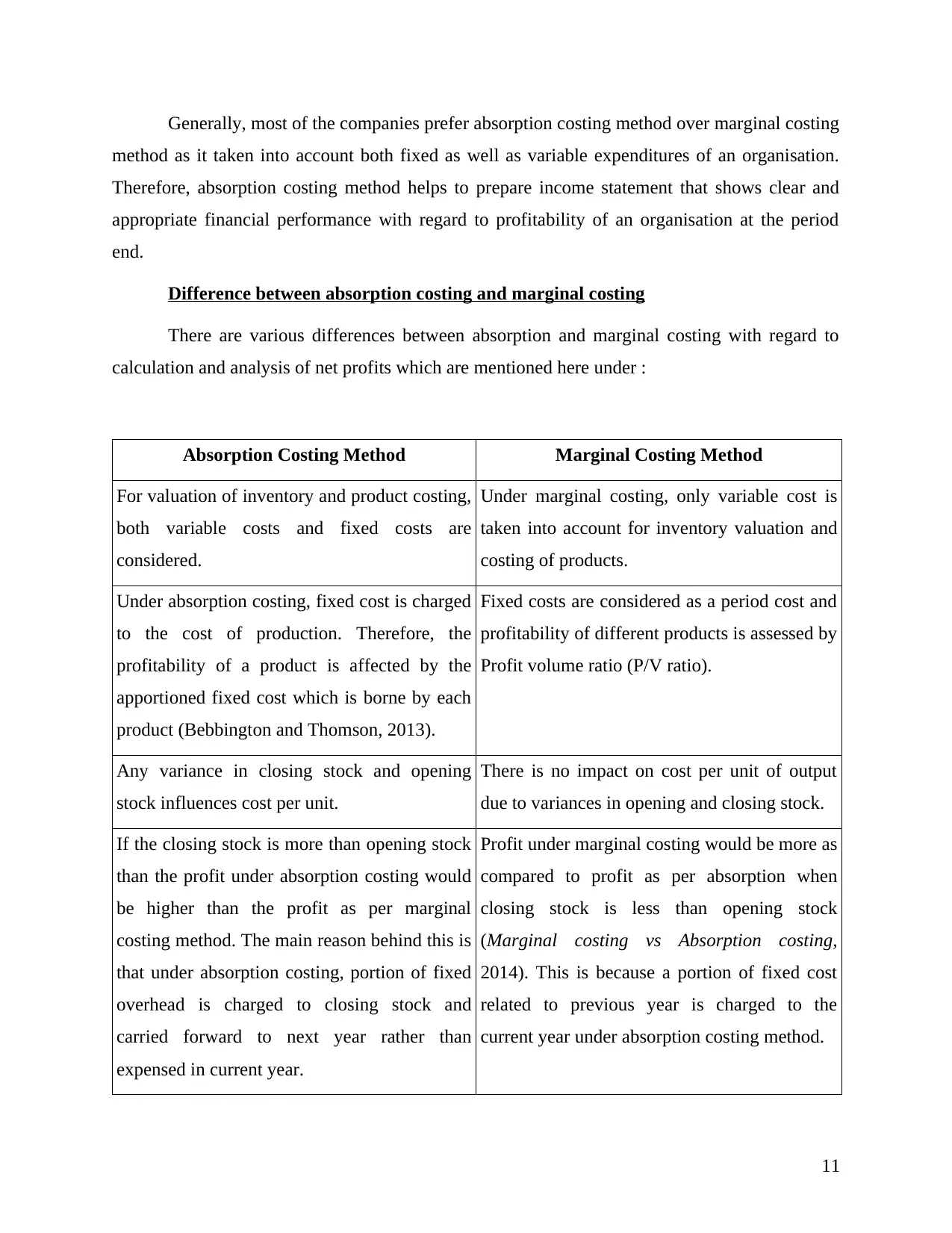
Generally, most of the companies prefer absorption costing method over marginal costing
method as it taken into account both fixed as well as variable expenditures of an organisation.
Therefore, absorption costing method helps to prepare income statement that shows clear and
appropriate financial performance with regard to profitability of an organisation at the period
end.
Difference between absorption costing and marginal costing
There are various differences between absorption and marginal costing with regard to
calculation and analysis of net profits which are mentioned here under :
Absorption Costing Method Marginal Costing Method
For valuation of inventory and product costing,
both variable costs and fixed costs are
considered.
Under marginal costing, only variable cost is
taken into account for inventory valuation and
costing of products.
Under absorption costing, fixed cost is charged
to the cost of production. Therefore, the
profitability of a product is affected by the
apportioned fixed cost which is borne by each
product (Bebbington and Thomson, 2013).
Fixed costs are considered as a period cost and
profitability of different products is assessed by
Profit volume ratio (P/V ratio).
Any variance in closing stock and opening
stock influences cost per unit.
There is no impact on cost per unit of output
due to variances in opening and closing stock.
If the closing stock is more than opening stock
than the profit under absorption costing would
be higher than the profit as per marginal
costing method. The main reason behind this is
that under absorption costing, portion of fixed
overhead is charged to closing stock and
carried forward to next year rather than
expensed in current year.
Profit under marginal costing would be more as
compared to profit as per absorption when
closing stock is less than opening stock
(Marginal costing vs Absorption costing,
2014). This is because a portion of fixed cost
related to previous year is charged to the
current year under absorption costing method.
11
method as it taken into account both fixed as well as variable expenditures of an organisation.
Therefore, absorption costing method helps to prepare income statement that shows clear and
appropriate financial performance with regard to profitability of an organisation at the period
end.
Difference between absorption costing and marginal costing
There are various differences between absorption and marginal costing with regard to
calculation and analysis of net profits which are mentioned here under :
Absorption Costing Method Marginal Costing Method
For valuation of inventory and product costing,
both variable costs and fixed costs are
considered.
Under marginal costing, only variable cost is
taken into account for inventory valuation and
costing of products.
Under absorption costing, fixed cost is charged
to the cost of production. Therefore, the
profitability of a product is affected by the
apportioned fixed cost which is borne by each
product (Bebbington and Thomson, 2013).
Fixed costs are considered as a period cost and
profitability of different products is assessed by
Profit volume ratio (P/V ratio).
Any variance in closing stock and opening
stock influences cost per unit.
There is no impact on cost per unit of output
due to variances in opening and closing stock.
If the closing stock is more than opening stock
than the profit under absorption costing would
be higher than the profit as per marginal
costing method. The main reason behind this is
that under absorption costing, portion of fixed
overhead is charged to closing stock and
carried forward to next year rather than
expensed in current year.
Profit under marginal costing would be more as
compared to profit as per absorption when
closing stock is less than opening stock
(Marginal costing vs Absorption costing,
2014). This is because a portion of fixed cost
related to previous year is charged to the
current year under absorption costing method.
11
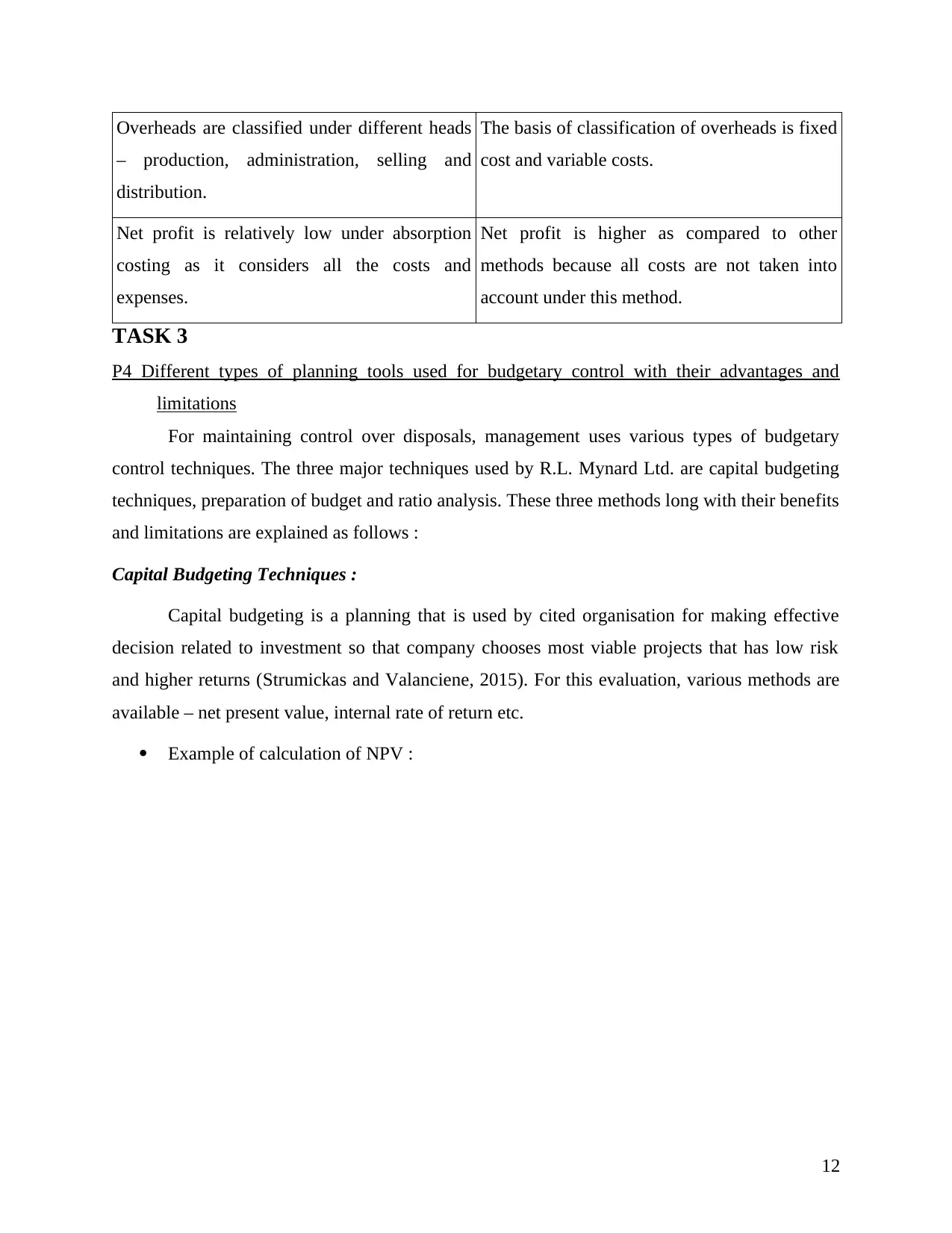
Overheads are classified under different heads
– production, administration, selling and
distribution.
The basis of classification of overheads is fixed
cost and variable costs.
Net profit is relatively low under absorption
costing as it considers all the costs and
expenses.
Net profit is higher as compared to other
methods because all costs are not taken into
account under this method.
TASK 3
P4 Different types of planning tools used for budgetary control with their advantages and
limitations
For maintaining control over disposals, management uses various types of budgetary
control techniques. The three major techniques used by R.L. Mynard Ltd. are capital budgeting
techniques, preparation of budget and ratio analysis. These three methods long with their benefits
and limitations are explained as follows :
Capital Budgeting Techniques :
Capital budgeting is a planning that is used by cited organisation for making effective
decision related to investment so that company chooses most viable projects that has low risk
and higher returns (Strumickas and Valanciene, 2015). For this evaluation, various methods are
available – net present value, internal rate of return etc.
Example of calculation of NPV :
12
– production, administration, selling and
distribution.
The basis of classification of overheads is fixed
cost and variable costs.
Net profit is relatively low under absorption
costing as it considers all the costs and
expenses.
Net profit is higher as compared to other
methods because all costs are not taken into
account under this method.
TASK 3
P4 Different types of planning tools used for budgetary control with their advantages and
limitations
For maintaining control over disposals, management uses various types of budgetary
control techniques. The three major techniques used by R.L. Mynard Ltd. are capital budgeting
techniques, preparation of budget and ratio analysis. These three methods long with their benefits
and limitations are explained as follows :
Capital Budgeting Techniques :
Capital budgeting is a planning that is used by cited organisation for making effective
decision related to investment so that company chooses most viable projects that has low risk
and higher returns (Strumickas and Valanciene, 2015). For this evaluation, various methods are
available – net present value, internal rate of return etc.
Example of calculation of NPV :
12
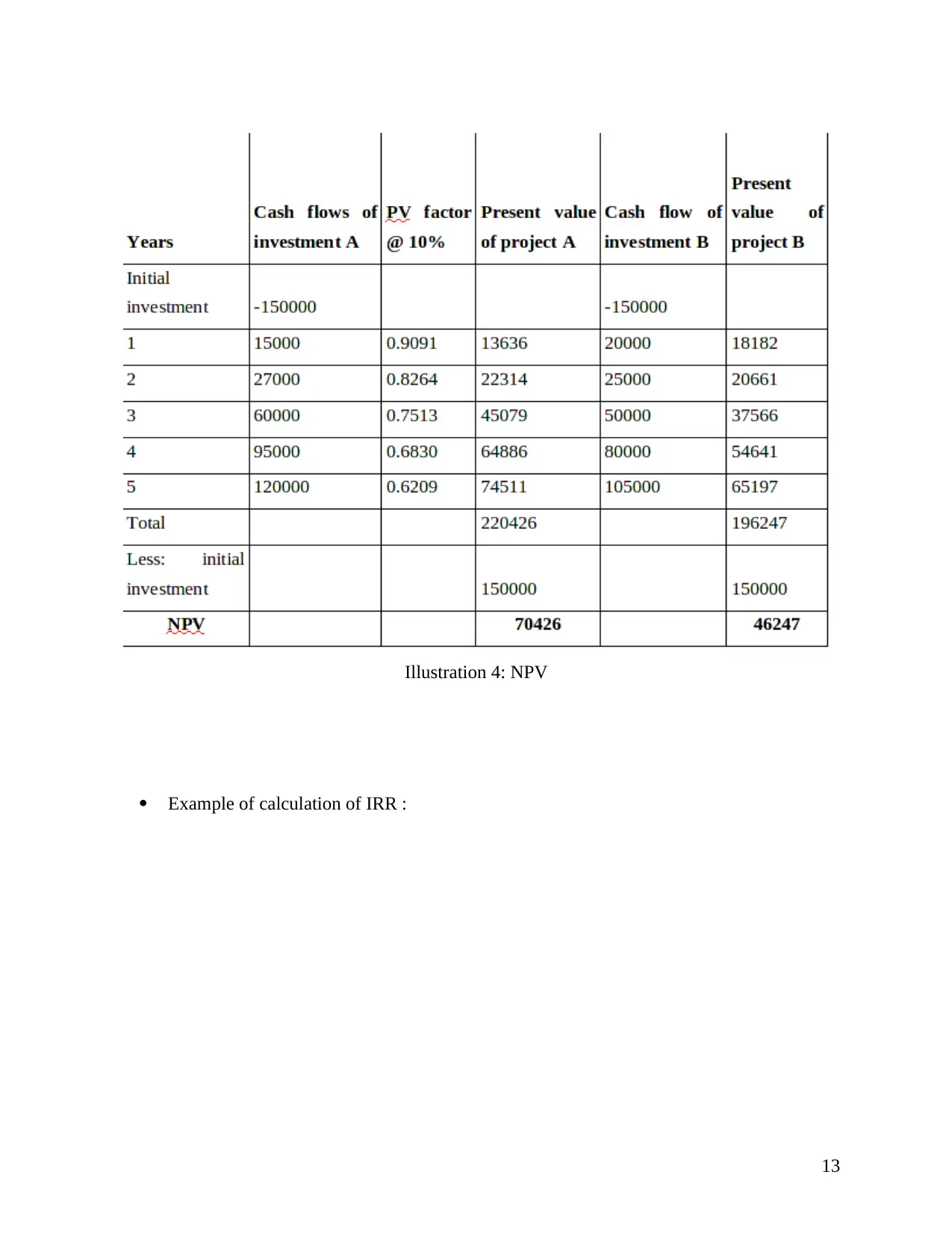
Example of calculation of IRR :
13
Illustration 4: NPV
13
Illustration 4: NPV
Secure Best Marks with AI Grader
Need help grading? Try our AI Grader for instant feedback on your assignments.
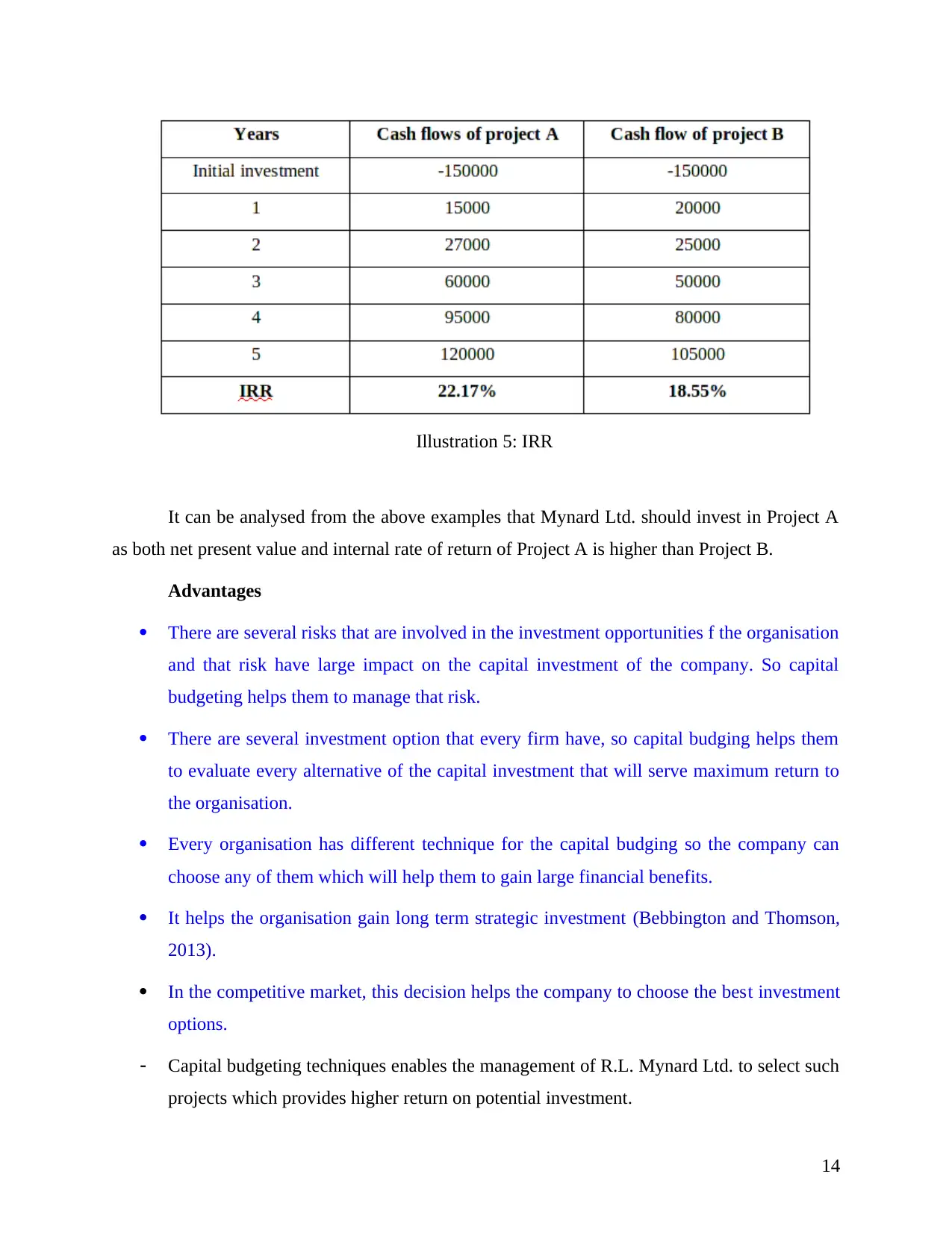
It can be analysed from the above examples that Mynard Ltd. should invest in Project A
as both net present value and internal rate of return of Project A is higher than Project B.
Advantages
There are several risks that are involved in the investment opportunities f the organisation
and that risk have large impact on the capital investment of the company. So capital
budgeting helps them to manage that risk.
There are several investment option that every firm have, so capital budging helps them
to evaluate every alternative of the capital investment that will serve maximum return to
the organisation.
Every organisation has different technique for the capital budging so the company can
choose any of them which will help them to gain large financial benefits.
It helps the organisation gain long term strategic investment (Bebbington and Thomson,
2013).
In the competitive market, this decision helps the company to choose the best investment
options.
Capital budgeting techniques enables the management of R.L. Mynard Ltd. to select such
projects which provides higher return on potential investment.
14
Illustration 5: IRR
as both net present value and internal rate of return of Project A is higher than Project B.
Advantages
There are several risks that are involved in the investment opportunities f the organisation
and that risk have large impact on the capital investment of the company. So capital
budgeting helps them to manage that risk.
There are several investment option that every firm have, so capital budging helps them
to evaluate every alternative of the capital investment that will serve maximum return to
the organisation.
Every organisation has different technique for the capital budging so the company can
choose any of them which will help them to gain large financial benefits.
It helps the organisation gain long term strategic investment (Bebbington and Thomson,
2013).
In the competitive market, this decision helps the company to choose the best investment
options.
Capital budgeting techniques enables the management of R.L. Mynard Ltd. to select such
projects which provides higher return on potential investment.
14
Illustration 5: IRR
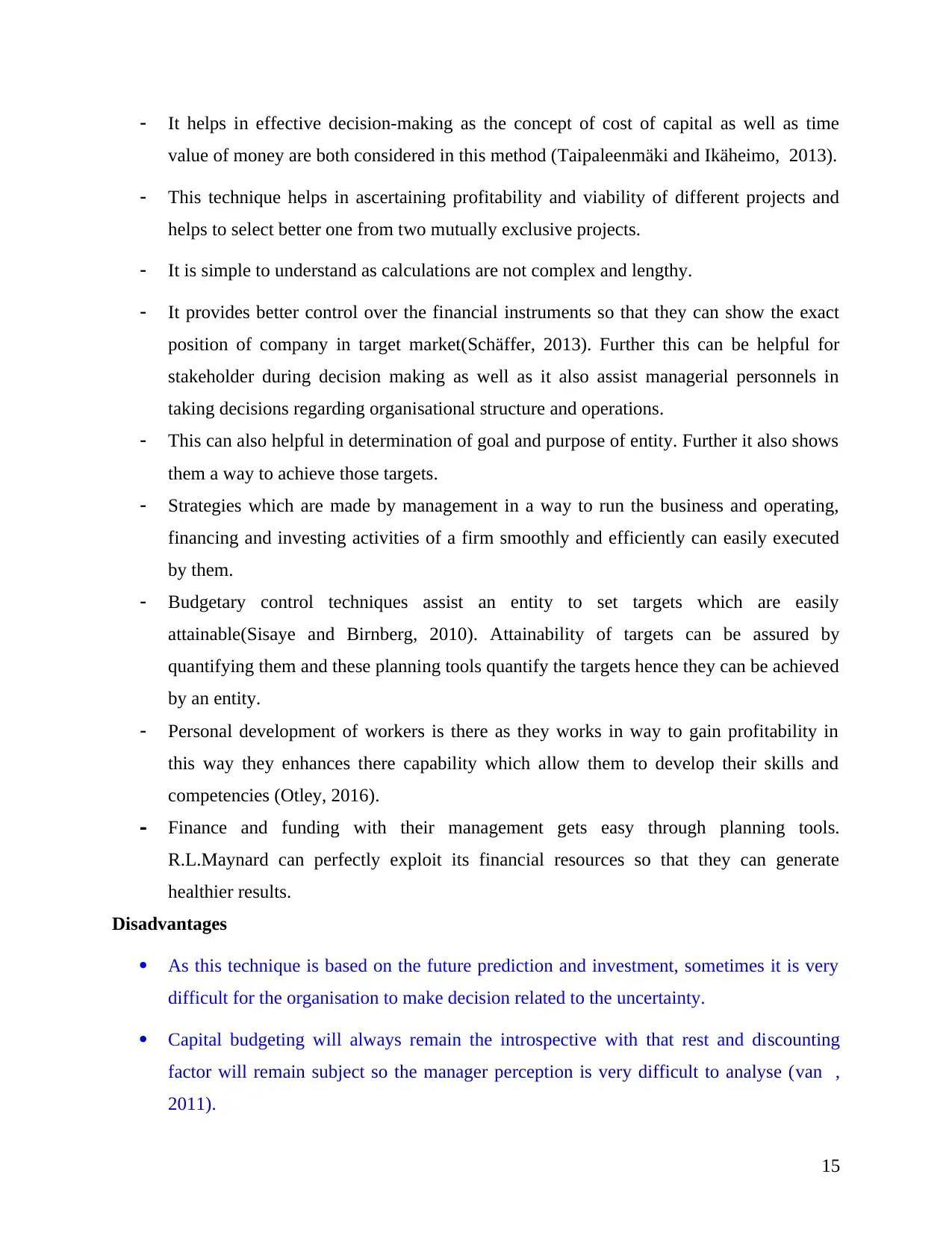
It helps in effective decision-making as the concept of cost of capital as well as time
value of money are both considered in this method (Taipaleenmäki and Ikäheimo, 2013).
This technique helps in ascertaining profitability and viability of different projects and
helps to select better one from two mutually exclusive projects.
It is simple to understand as calculations are not complex and lengthy.
It provides better control over the financial instruments so that they can show the exact
position of company in target market(Schäffer, 2013). Further this can be helpful for
stakeholder during decision making as well as it also assist managerial personnels in
taking decisions regarding organisational structure and operations.
This can also helpful in determination of goal and purpose of entity. Further it also shows
them a way to achieve those targets.
Strategies which are made by management in a way to run the business and operating,
financing and investing activities of a firm smoothly and efficiently can easily executed
by them.
Budgetary control techniques assist an entity to set targets which are easily
attainable(Sisaye and Birnberg, 2010). Attainability of targets can be assured by
quantifying them and these planning tools quantify the targets hence they can be achieved
by an entity.
Personal development of workers is there as they works in way to gain profitability in
this way they enhances there capability which allow them to develop their skills and
competencies (Otley, 2016).
Finance and funding with their management gets easy through planning tools.
R.L.Maynard can perfectly exploit its financial resources so that they can generate
healthier results.
Disadvantages
As this technique is based on the future prediction and investment, sometimes it is very
difficult for the organisation to make decision related to the uncertainty.
Capital budgeting will always remain the introspective with that rest and discounting
factor will remain subject so the manager perception is very difficult to analyse (van ,
2011).
15
value of money are both considered in this method (Taipaleenmäki and Ikäheimo, 2013).
This technique helps in ascertaining profitability and viability of different projects and
helps to select better one from two mutually exclusive projects.
It is simple to understand as calculations are not complex and lengthy.
It provides better control over the financial instruments so that they can show the exact
position of company in target market(Schäffer, 2013). Further this can be helpful for
stakeholder during decision making as well as it also assist managerial personnels in
taking decisions regarding organisational structure and operations.
This can also helpful in determination of goal and purpose of entity. Further it also shows
them a way to achieve those targets.
Strategies which are made by management in a way to run the business and operating,
financing and investing activities of a firm smoothly and efficiently can easily executed
by them.
Budgetary control techniques assist an entity to set targets which are easily
attainable(Sisaye and Birnberg, 2010). Attainability of targets can be assured by
quantifying them and these planning tools quantify the targets hence they can be achieved
by an entity.
Personal development of workers is there as they works in way to gain profitability in
this way they enhances there capability which allow them to develop their skills and
competencies (Otley, 2016).
Finance and funding with their management gets easy through planning tools.
R.L.Maynard can perfectly exploit its financial resources so that they can generate
healthier results.
Disadvantages
As this technique is based on the future prediction and investment, sometimes it is very
difficult for the organisation to make decision related to the uncertainty.
Capital budgeting will always remain the introspective with that rest and discounting
factor will remain subject so the manager perception is very difficult to analyse (van ,
2011).
15
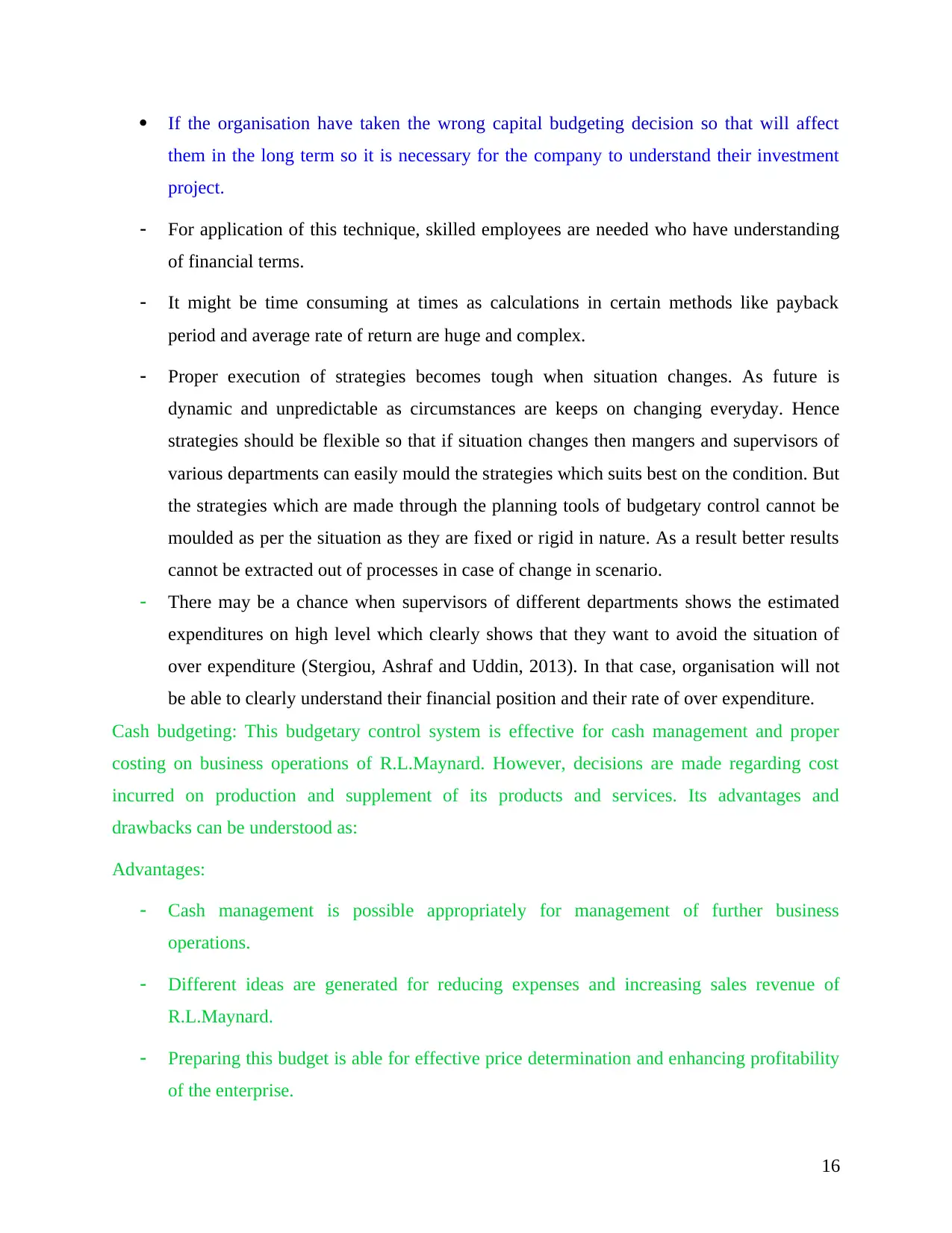
If the organisation have taken the wrong capital budgeting decision so that will affect
them in the long term so it is necessary for the company to understand their investment
project.
For application of this technique, skilled employees are needed who have understanding
of financial terms.
It might be time consuming at times as calculations in certain methods like payback
period and average rate of return are huge and complex.
Proper execution of strategies becomes tough when situation changes. As future is
dynamic and unpredictable as circumstances are keeps on changing everyday. Hence
strategies should be flexible so that if situation changes then mangers and supervisors of
various departments can easily mould the strategies which suits best on the condition. But
the strategies which are made through the planning tools of budgetary control cannot be
moulded as per the situation as they are fixed or rigid in nature. As a result better results
cannot be extracted out of processes in case of change in scenario.
There may be a chance when supervisors of different departments shows the estimated
expenditures on high level which clearly shows that they want to avoid the situation of
over expenditure (Stergiou, Ashraf and Uddin, 2013). In that case, organisation will not
be able to clearly understand their financial position and their rate of over expenditure.
Cash budgeting: This budgetary control system is effective for cash management and proper
costing on business operations of R.L.Maynard. However, decisions are made regarding cost
incurred on production and supplement of its products and services. Its advantages and
drawbacks can be understood as:
Advantages:
Cash management is possible appropriately for management of further business
operations.
Different ideas are generated for reducing expenses and increasing sales revenue of
R.L.Maynard.
Preparing this budget is able for effective price determination and enhancing profitability
of the enterprise.
16
them in the long term so it is necessary for the company to understand their investment
project.
For application of this technique, skilled employees are needed who have understanding
of financial terms.
It might be time consuming at times as calculations in certain methods like payback
period and average rate of return are huge and complex.
Proper execution of strategies becomes tough when situation changes. As future is
dynamic and unpredictable as circumstances are keeps on changing everyday. Hence
strategies should be flexible so that if situation changes then mangers and supervisors of
various departments can easily mould the strategies which suits best on the condition. But
the strategies which are made through the planning tools of budgetary control cannot be
moulded as per the situation as they are fixed or rigid in nature. As a result better results
cannot be extracted out of processes in case of change in scenario.
There may be a chance when supervisors of different departments shows the estimated
expenditures on high level which clearly shows that they want to avoid the situation of
over expenditure (Stergiou, Ashraf and Uddin, 2013). In that case, organisation will not
be able to clearly understand their financial position and their rate of over expenditure.
Cash budgeting: This budgetary control system is effective for cash management and proper
costing on business operations of R.L.Maynard. However, decisions are made regarding cost
incurred on production and supplement of its products and services. Its advantages and
drawbacks can be understood as:
Advantages:
Cash management is possible appropriately for management of further business
operations.
Different ideas are generated for reducing expenses and increasing sales revenue of
R.L.Maynard.
Preparing this budget is able for effective price determination and enhancing profitability
of the enterprise.
16
Paraphrase This Document
Need a fresh take? Get an instant paraphrase of this document with our AI Paraphraser
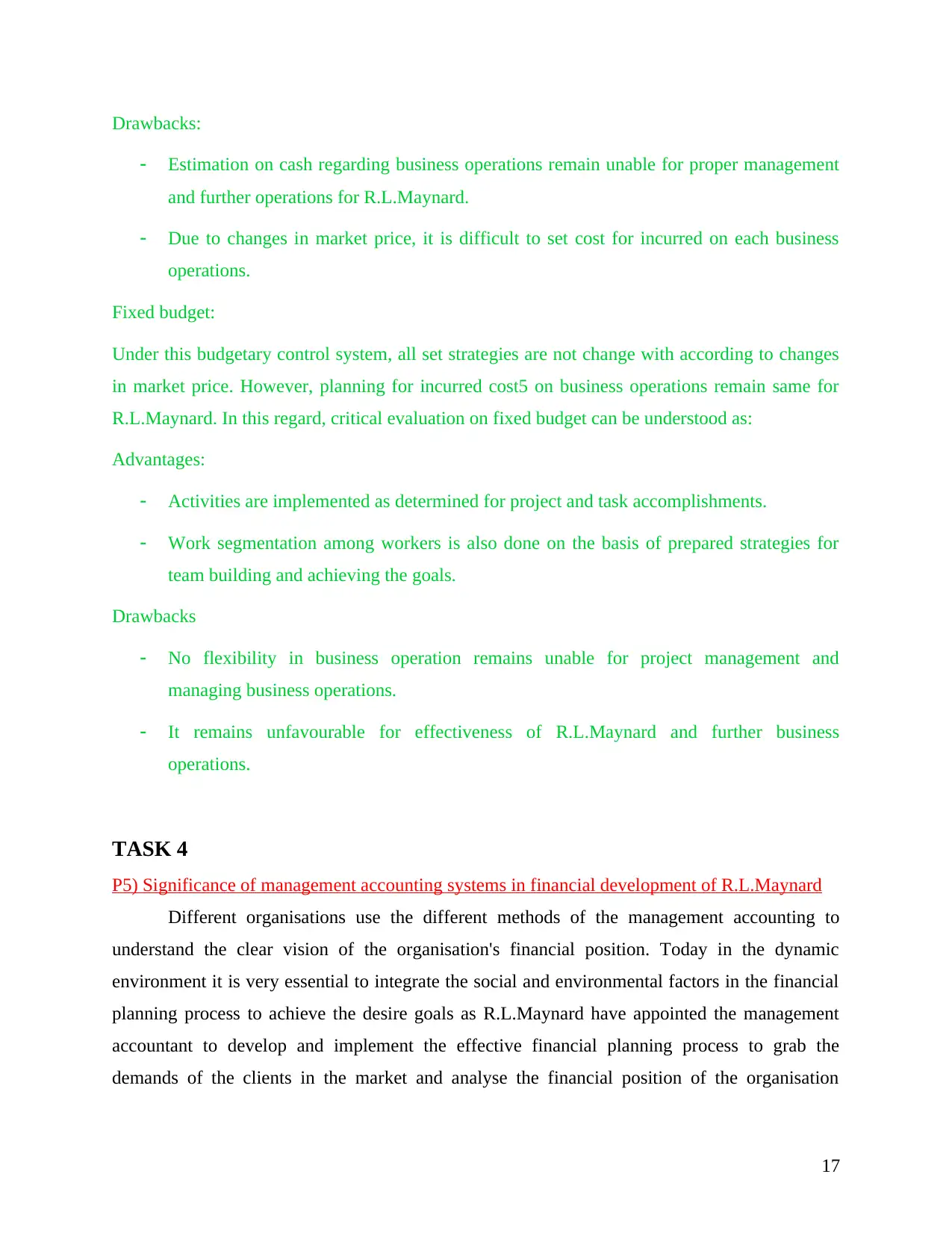
Drawbacks:
Estimation on cash regarding business operations remain unable for proper management
and further operations for R.L.Maynard.
Due to changes in market price, it is difficult to set cost for incurred on each business
operations.
Fixed budget:
Under this budgetary control system, all set strategies are not change with according to changes
in market price. However, planning for incurred cost5 on business operations remain same for
R.L.Maynard. In this regard, critical evaluation on fixed budget can be understood as:
Advantages:
Activities are implemented as determined for project and task accomplishments.
Work segmentation among workers is also done on the basis of prepared strategies for
team building and achieving the goals.
Drawbacks
No flexibility in business operation remains unable for project management and
managing business operations.
It remains unfavourable for effectiveness of R.L.Maynard and further business
operations.
TASK 4
P5) Significance of management accounting systems in financial development of R.L.Maynard
Different organisations use the different methods of the management accounting to
understand the clear vision of the organisation's financial position. Today in the dynamic
environment it is very essential to integrate the social and environmental factors in the financial
planning process to achieve the desire goals as R.L.Maynard have appointed the management
accountant to develop and implement the effective financial planning process to grab the
demands of the clients in the market and analyse the financial position of the organisation
17
Estimation on cash regarding business operations remain unable for proper management
and further operations for R.L.Maynard.
Due to changes in market price, it is difficult to set cost for incurred on each business
operations.
Fixed budget:
Under this budgetary control system, all set strategies are not change with according to changes
in market price. However, planning for incurred cost5 on business operations remain same for
R.L.Maynard. In this regard, critical evaluation on fixed budget can be understood as:
Advantages:
Activities are implemented as determined for project and task accomplishments.
Work segmentation among workers is also done on the basis of prepared strategies for
team building and achieving the goals.
Drawbacks
No flexibility in business operation remains unable for project management and
managing business operations.
It remains unfavourable for effectiveness of R.L.Maynard and further business
operations.
TASK 4
P5) Significance of management accounting systems in financial development of R.L.Maynard
Different organisations use the different methods of the management accounting to
understand the clear vision of the organisation's financial position. Today in the dynamic
environment it is very essential to integrate the social and environmental factors in the financial
planning process to achieve the desire goals as R.L.Maynard have appointed the management
accountant to develop and implement the effective financial planning process to grab the
demands of the clients in the market and analyse the financial position of the organisation
17
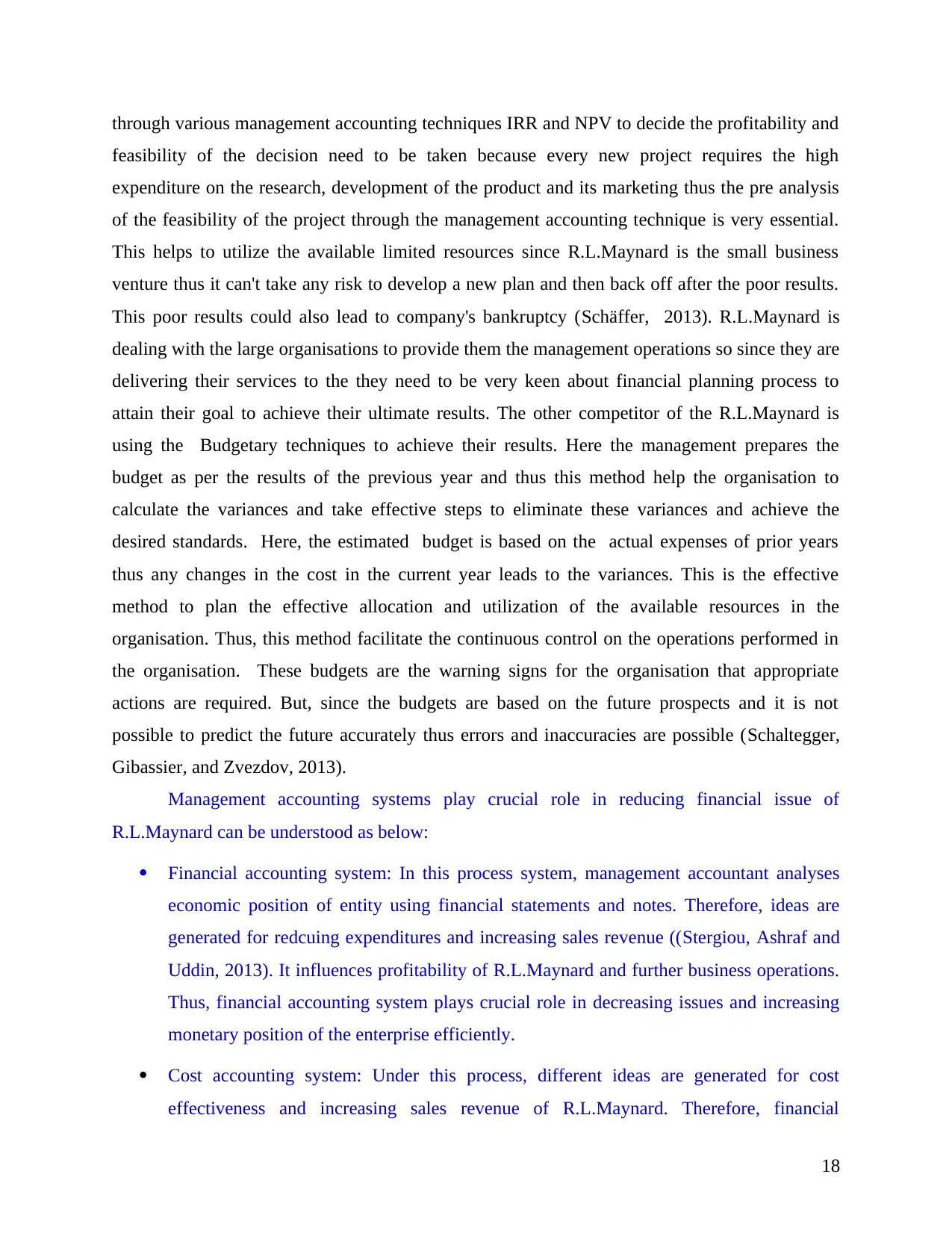
through various management accounting techniques IRR and NPV to decide the profitability and
feasibility of the decision need to be taken because every new project requires the high
expenditure on the research, development of the product and its marketing thus the pre analysis
of the feasibility of the project through the management accounting technique is very essential.
This helps to utilize the available limited resources since R.L.Maynard is the small business
venture thus it can't take any risk to develop a new plan and then back off after the poor results.
This poor results could also lead to company's bankruptcy (Schäffer, 2013). R.L.Maynard is
dealing with the large organisations to provide them the management operations so since they are
delivering their services to the they need to be very keen about financial planning process to
attain their goal to achieve their ultimate results. The other competitor of the R.L.Maynard is
using the Budgetary techniques to achieve their results. Here the management prepares the
budget as per the results of the previous year and thus this method help the organisation to
calculate the variances and take effective steps to eliminate these variances and achieve the
desired standards. Here, the estimated budget is based on the actual expenses of prior years
thus any changes in the cost in the current year leads to the variances. This is the effective
method to plan the effective allocation and utilization of the available resources in the
organisation. Thus, this method facilitate the continuous control on the operations performed in
the organisation. These budgets are the warning signs for the organisation that appropriate
actions are required. But, since the budgets are based on the future prospects and it is not
possible to predict the future accurately thus errors and inaccuracies are possible (Schaltegger,
Gibassier, and Zvezdov, 2013).
Management accounting systems play crucial role in reducing financial issue of
R.L.Maynard can be understood as below:
Financial accounting system: In this process system, management accountant analyses
economic position of entity using financial statements and notes. Therefore, ideas are
generated for redcuing expenditures and increasing sales revenue ((Stergiou, Ashraf and
Uddin, 2013). It influences profitability of R.L.Maynard and further business operations.
Thus, financial accounting system plays crucial role in decreasing issues and increasing
monetary position of the enterprise efficiently.
Cost accounting system: Under this process, different ideas are generated for cost
effectiveness and increasing sales revenue of R.L.Maynard. Therefore, financial
18
feasibility of the decision need to be taken because every new project requires the high
expenditure on the research, development of the product and its marketing thus the pre analysis
of the feasibility of the project through the management accounting technique is very essential.
This helps to utilize the available limited resources since R.L.Maynard is the small business
venture thus it can't take any risk to develop a new plan and then back off after the poor results.
This poor results could also lead to company's bankruptcy (Schäffer, 2013). R.L.Maynard is
dealing with the large organisations to provide them the management operations so since they are
delivering their services to the they need to be very keen about financial planning process to
attain their goal to achieve their ultimate results. The other competitor of the R.L.Maynard is
using the Budgetary techniques to achieve their results. Here the management prepares the
budget as per the results of the previous year and thus this method help the organisation to
calculate the variances and take effective steps to eliminate these variances and achieve the
desired standards. Here, the estimated budget is based on the actual expenses of prior years
thus any changes in the cost in the current year leads to the variances. This is the effective
method to plan the effective allocation and utilization of the available resources in the
organisation. Thus, this method facilitate the continuous control on the operations performed in
the organisation. These budgets are the warning signs for the organisation that appropriate
actions are required. But, since the budgets are based on the future prospects and it is not
possible to predict the future accurately thus errors and inaccuracies are possible (Schaltegger,
Gibassier, and Zvezdov, 2013).
Management accounting systems play crucial role in reducing financial issue of
R.L.Maynard can be understood as below:
Financial accounting system: In this process system, management accountant analyses
economic position of entity using financial statements and notes. Therefore, ideas are
generated for redcuing expenditures and increasing sales revenue ((Stergiou, Ashraf and
Uddin, 2013). It influences profitability of R.L.Maynard and further business operations.
Thus, financial accounting system plays crucial role in decreasing issues and increasing
monetary position of the enterprise efficiently.
Cost accounting system: Under this process, different ideas are generated for cost
effectiveness and increasing sales revenue of R.L.Maynard. Therefore, financial
18
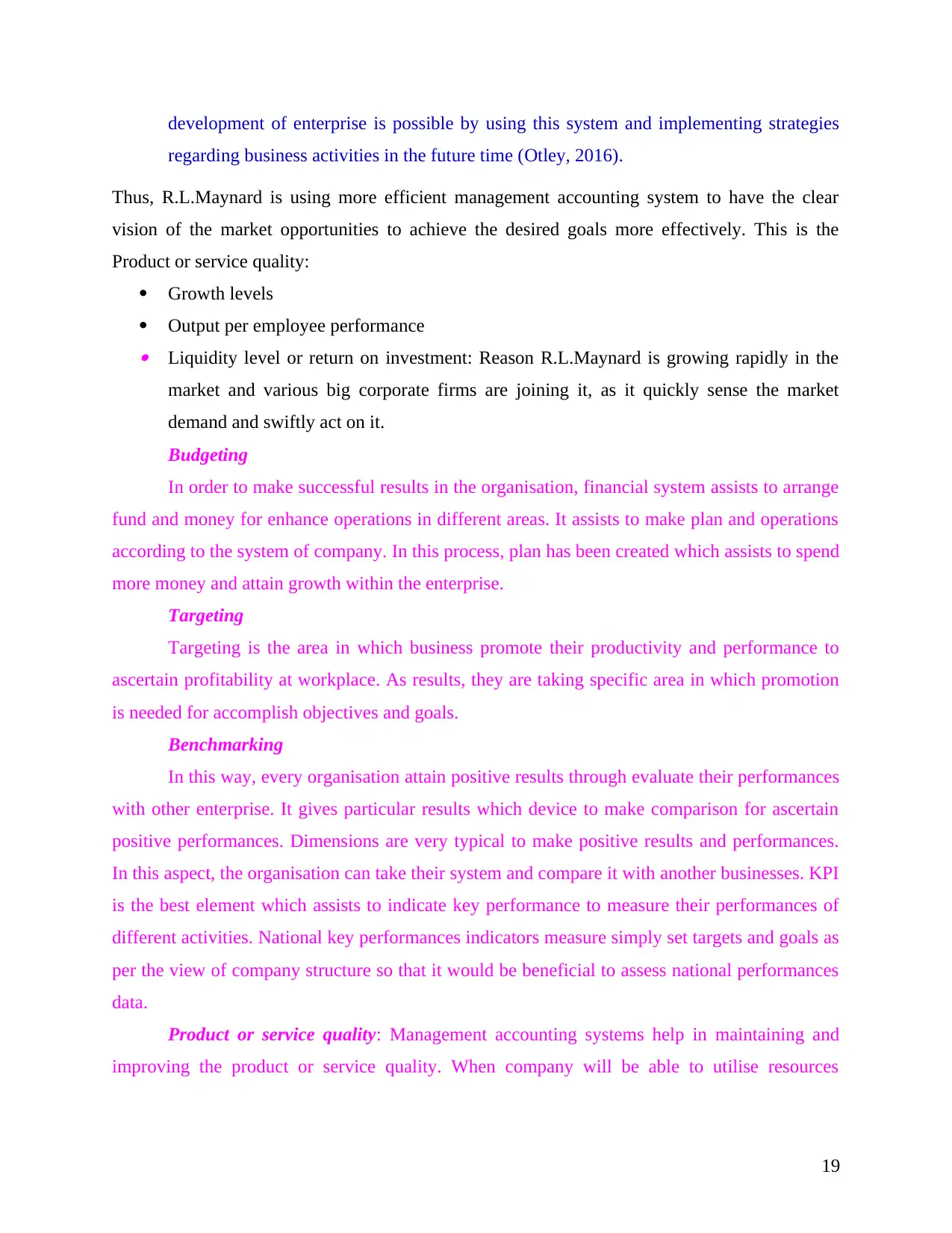
development of enterprise is possible by using this system and implementing strategies
regarding business activities in the future time (Otley, 2016).
Thus, R.L.Maynard is using more efficient management accounting system to have the clear
vision of the market opportunities to achieve the desired goals more effectively. This is the
Product or service quality:
Growth levels
Output per employee performance Liquidity level or return on investment: Reason R.L.Maynard is growing rapidly in the
market and various big corporate firms are joining it, as it quickly sense the market
demand and swiftly act on it.
Budgeting
In order to make successful results in the organisation, financial system assists to arrange
fund and money for enhance operations in different areas. It assists to make plan and operations
according to the system of company. In this process, plan has been created which assists to spend
more money and attain growth within the enterprise.
Targeting
Targeting is the area in which business promote their productivity and performance to
ascertain profitability at workplace. As results, they are taking specific area in which promotion
is needed for accomplish objectives and goals.
Benchmarking
In this way, every organisation attain positive results through evaluate their performances
with other enterprise. It gives particular results which device to make comparison for ascertain
positive performances. Dimensions are very typical to make positive results and performances.
In this aspect, the organisation can take their system and compare it with another businesses. KPI
is the best element which assists to indicate key performance to measure their performances of
different activities. National key performances indicators measure simply set targets and goals as
per the view of company structure so that it would be beneficial to assess national performances
data.
Product or service quality: Management accounting systems help in maintaining and
improving the product or service quality. When company will be able to utilise resources
19
regarding business activities in the future time (Otley, 2016).
Thus, R.L.Maynard is using more efficient management accounting system to have the clear
vision of the market opportunities to achieve the desired goals more effectively. This is the
Product or service quality:
Growth levels
Output per employee performance Liquidity level or return on investment: Reason R.L.Maynard is growing rapidly in the
market and various big corporate firms are joining it, as it quickly sense the market
demand and swiftly act on it.
Budgeting
In order to make successful results in the organisation, financial system assists to arrange
fund and money for enhance operations in different areas. It assists to make plan and operations
according to the system of company. In this process, plan has been created which assists to spend
more money and attain growth within the enterprise.
Targeting
Targeting is the area in which business promote their productivity and performance to
ascertain profitability at workplace. As results, they are taking specific area in which promotion
is needed for accomplish objectives and goals.
Benchmarking
In this way, every organisation attain positive results through evaluate their performances
with other enterprise. It gives particular results which device to make comparison for ascertain
positive performances. Dimensions are very typical to make positive results and performances.
In this aspect, the organisation can take their system and compare it with another businesses. KPI
is the best element which assists to indicate key performance to measure their performances of
different activities. National key performances indicators measure simply set targets and goals as
per the view of company structure so that it would be beneficial to assess national performances
data.
Product or service quality: Management accounting systems help in maintaining and
improving the product or service quality. When company will be able to utilise resources
19
Secure Best Marks with AI Grader
Need help grading? Try our AI Grader for instant feedback on your assignments.
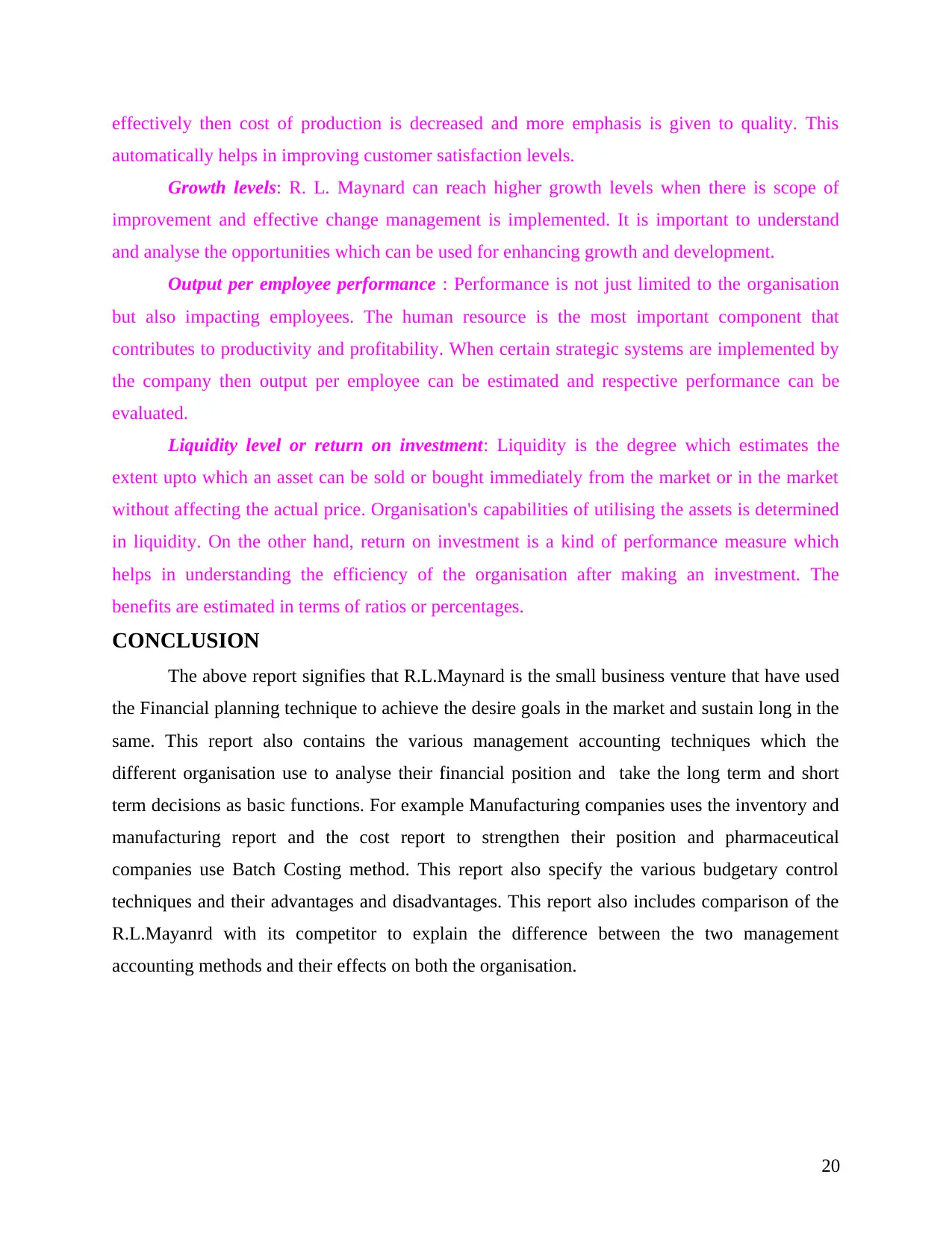
effectively then cost of production is decreased and more emphasis is given to quality. This
automatically helps in improving customer satisfaction levels.
Growth levels: R. L. Maynard can reach higher growth levels when there is scope of
improvement and effective change management is implemented. It is important to understand
and analyse the opportunities which can be used for enhancing growth and development.
Output per employee performance : Performance is not just limited to the organisation
but also impacting employees. The human resource is the most important component that
contributes to productivity and profitability. When certain strategic systems are implemented by
the company then output per employee can be estimated and respective performance can be
evaluated.
Liquidity level or return on investment: Liquidity is the degree which estimates the
extent upto which an asset can be sold or bought immediately from the market or in the market
without affecting the actual price. Organisation's capabilities of utilising the assets is determined
in liquidity. On the other hand, return on investment is a kind of performance measure which
helps in understanding the efficiency of the organisation after making an investment. The
benefits are estimated in terms of ratios or percentages.
CONCLUSION
The above report signifies that R.L.Maynard is the small business venture that have used
the Financial planning technique to achieve the desire goals in the market and sustain long in the
same. This report also contains the various management accounting techniques which the
different organisation use to analyse their financial position and take the long term and short
term decisions as basic functions. For example Manufacturing companies uses the inventory and
manufacturing report and the cost report to strengthen their position and pharmaceutical
companies use Batch Costing method. This report also specify the various budgetary control
techniques and their advantages and disadvantages. This report also includes comparison of the
R.L.Mayanrd with its competitor to explain the difference between the two management
accounting methods and their effects on both the organisation.
20
automatically helps in improving customer satisfaction levels.
Growth levels: R. L. Maynard can reach higher growth levels when there is scope of
improvement and effective change management is implemented. It is important to understand
and analyse the opportunities which can be used for enhancing growth and development.
Output per employee performance : Performance is not just limited to the organisation
but also impacting employees. The human resource is the most important component that
contributes to productivity and profitability. When certain strategic systems are implemented by
the company then output per employee can be estimated and respective performance can be
evaluated.
Liquidity level or return on investment: Liquidity is the degree which estimates the
extent upto which an asset can be sold or bought immediately from the market or in the market
without affecting the actual price. Organisation's capabilities of utilising the assets is determined
in liquidity. On the other hand, return on investment is a kind of performance measure which
helps in understanding the efficiency of the organisation after making an investment. The
benefits are estimated in terms of ratios or percentages.
CONCLUSION
The above report signifies that R.L.Maynard is the small business venture that have used
the Financial planning technique to achieve the desire goals in the market and sustain long in the
same. This report also contains the various management accounting techniques which the
different organisation use to analyse their financial position and take the long term and short
term decisions as basic functions. For example Manufacturing companies uses the inventory and
manufacturing report and the cost report to strengthen their position and pharmaceutical
companies use Batch Costing method. This report also specify the various budgetary control
techniques and their advantages and disadvantages. This report also includes comparison of the
R.L.Mayanrd with its competitor to explain the difference between the two management
accounting methods and their effects on both the organisation.
20
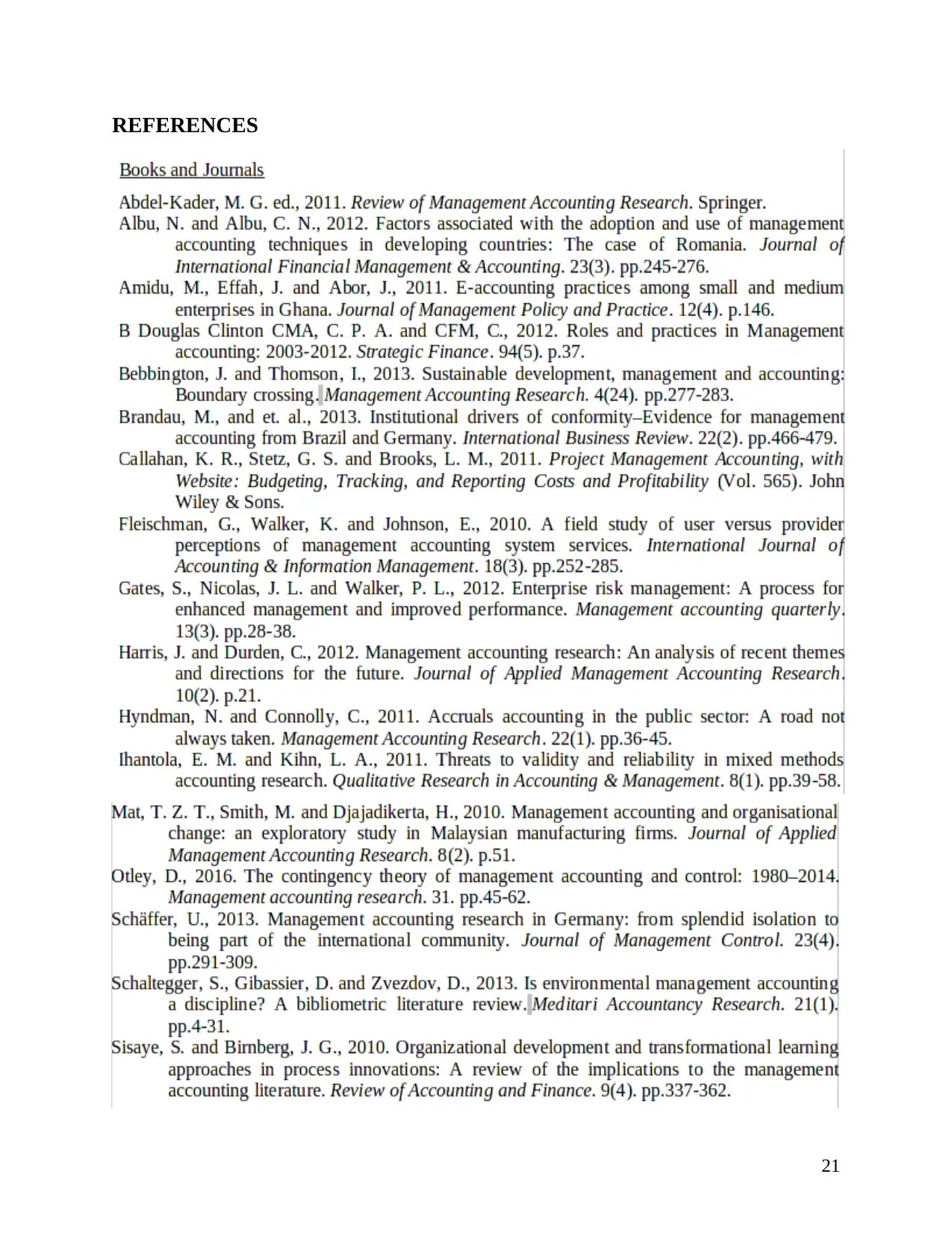
REFERENCES
21
21
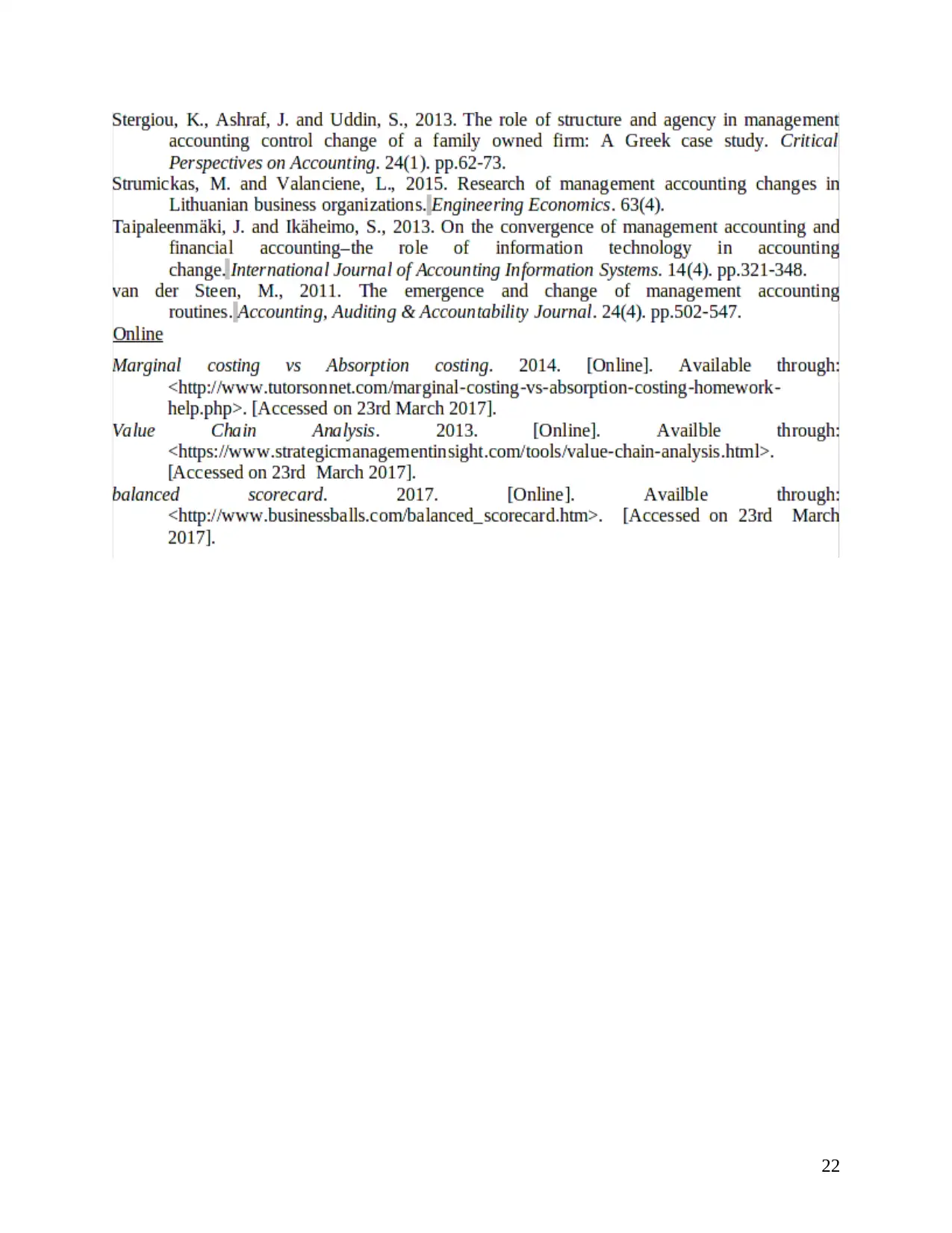
22
1 out of 25
Related Documents
Your All-in-One AI-Powered Toolkit for Academic Success.
+13062052269
info@desklib.com
Available 24*7 on WhatsApp / Email
![[object Object]](/_next/static/media/star-bottom.7253800d.svg)
Unlock your academic potential
© 2024 | Zucol Services PVT LTD | All rights reserved.





